PinotFile: 8.45 November 1, 2011
|
Davis Family Vineyards: On a Quest for “Perfect” Pinot Noir
Guy Davis, Founder/Farmer/Winemaker
The perfect Pinot Noir hasn’t been produced yet, but some of the ephemeral Pinot Noirs crafted by Guy Davis of Davis Family Vineyards have come darn close. Guy’s style matches bright, complex aromas and flavors with silky textures and impeccable balance, while capturing the essence of Russian River Valley terroir. I am not the only fan, for Davis Family Vineyards’ wines have won praise from wine critics such as Robert Parker, Jr., and have been awarded many Best of Class and Gold Medal accolades in numerous major wine competitions. Guy is a cerebral winemaker who clearly understands his quest. His “Top 5 Rules for Crafting Great Pinot” include the following: (1) Only grow on sites destined for greatness (Guy’s estate hillside vineyard in the middle of the Russian River Valley is a site blessed with the cool microclimate, soils and exposures of sunlight to please the delicate nature of Pinot Noir.); (2) Precision viticulture (Guy does not farm his 7 acres of Pinot Noir - he farms 9,274 vines, striving to get twelve to fourteen touches for every vine during the growing season from pruning to harvest.); (3) Pick on the right day! (Guy is obsessive, focused and fanatical about picking the right day to harvest. He strives to find the point at which flavors are ripe and supple, yet not beyond that fine line that can jeopardize the elegance and beauty of the finished wine.); (4) Smell, taste, and talk to the wines every week (Meticulous attention to the wines in the cellar with as little handling as possible is his mantra.); and (5) Be an expert at blending (You have to know what true greatness requires to achieve it). Guy came to wine as a teenager while working his way through college as a cook at a French restaurant. He was able to taste benchmark wines from all the famous regions of France, and became so knowledgeable, he was asked to buy the wine for the restaurant’s wine list. Although he was educated in economics and began his working career as a stockbroker, the stock market crash of 1987 made him rethink his career goals. He picked up a job as a wine buyer in Sonoma in 1989, and soon was working in the cellars of several boutique wineries in the region. It was a stint with winemaker Lori Olds at Sky Vineyards a top Mt. Veeder that persuaded him to pursue a career in winemaking. While taking classes at Santa Rosa City College and University of California Davis, he searched for the perfectly situated site to grow Pinot Noir. In 1996, Guy bought a hillside vineyard on Laguna Road in the Russian River Valley. The property featured an abandoned Zinfandel vineyard dating to 1896 that had been neglected for twenty years. He resurrected 2.8 acres of the original Zinfandel vines, and planted 7 acres of Pinot Noir, 2.5 acres of Syrah and 2 acres of Chardonnay (see vineyard map and vineyard photo below; photo is looking south with pinot noir at upper portion of the vineyard). Guy’s focus is on Pinot Noir but he produces a colorful and consistently stellar palate of wines including Russian River Valley Chardonnay (oaked and unoaked versions), Monterey County Riesling, Sierra Foothills Marsanne/Roussane/Viognier blend (Cuvée Luke), Russian River Valley Rosé (Cote Rosé), Syrah, Zinfandel, Napa Valley Cabernet Sauvignon, Old Vine Zinfandel Port, and Apply Brandy (APPLE-ATION). He has also produced wines from New Zealand and Argentina under the Gusto label. As a nod to his affection for artisan food production, he also offers a high-quality cold-pressed artisan olive oil from trees planted in 1906 in the Sierra Foothills.
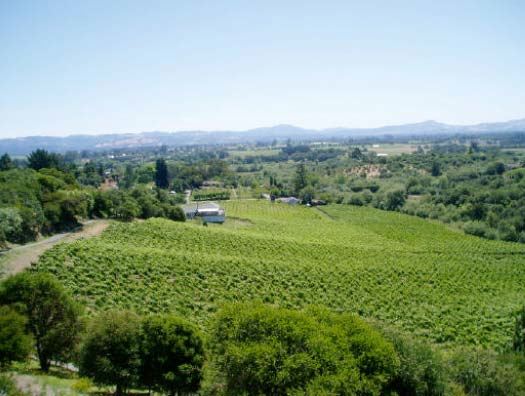
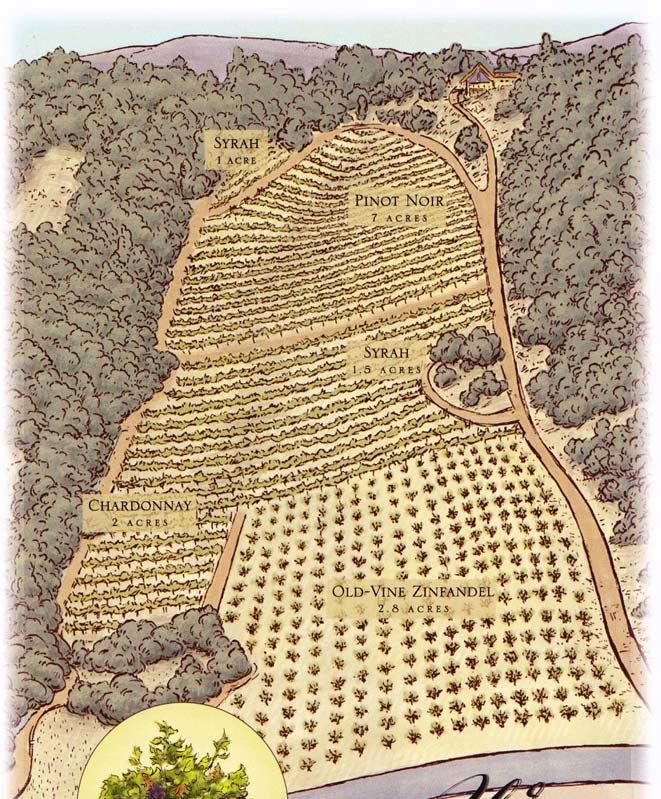 Guy’s flagship wine is the Davis Family Vineyards Russian River Valley Pinot Noir, a blend of all the Pinot Noir grown on the estate vineyard. Beginning in 2006, favorite barrels of estate Pinot Noir have been set aside as a special wine that receives additional barrel aging, the PinnaCole. Starting in 2008, a special bottling, Soul Patch, has been offered that is sourced from a unique part of the estate vineyard with a steep, east-facing slope that basks in the morning sun but avoids the harsh afternoon sun. Two vineyard-designated Pinot Noirs are also part of the portfolio, including Horseshoe Bend Vineyard located on the western edge of the Russian River Valley AVA and first produced in 2008, and Starr Ridge Vineyard, a 24-acre vineyard located in the hills just east of the Russian River and southwest of the town of Windsor, first appearing in 2009. A Sonoma Coast Pinot Noir completes the lineup. I recently sampled the 2009 Davis Family Vineyards Pinot Noirs as well as the recently released 2007 PinnaCole. These wines are very classy, among the upper echelon of Pinot Noirs currently being produced in the Russian River Valley. As a testament to the balance and age ability of these wines, all showed better the next day from previously opened and re-corked bottles. Although I may have liked a few of the wines slightly more than others, I would encourage you to try all these beauties and decide for yourself. The 2009 Pinot Noirs will be released in November 2011. Visit the website www.daviswines.com to order wine, or better yet, visit the tasting room located in the winery at 52 Front St. in Healdsburg and talk Pinot with Guy Davis. He is a soft-spoken winemaker who has a trove of wine information that he proffers in an understandable manner. Guy’s son, Cole, has quietly been assisting Guy in the estate vineyard and winery for seven years and has gradually assumed more winemaking responsibility. Guy has a soft spot for creative art and displays the work of local artists on his tasting room walls. The flamboyant artwork that guards the parking lot of his winery is a Healdsburg landmark.
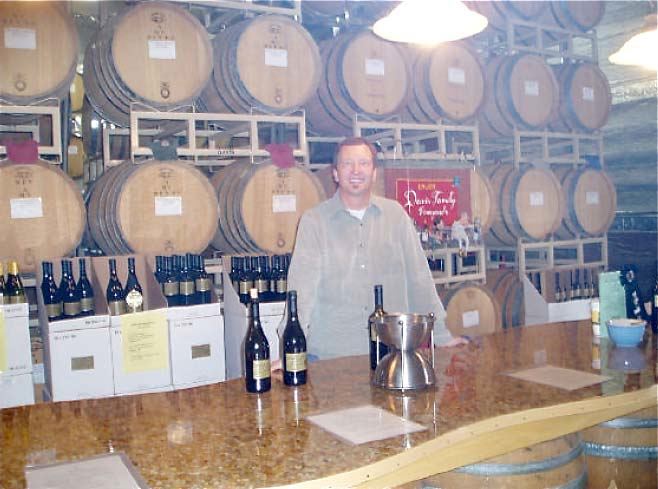
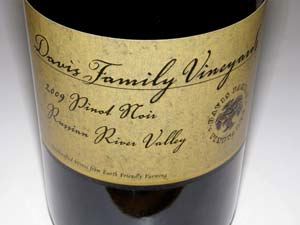 2009 Davis Family Vineyards Russian River Valley Pinot Noir 14.1% alc., 740 cases, $40. · Moderate reddish-purple hue in the glass. Lovely aromas of fresh Bing cherries and a hint of oak spice. The nose really draws you in. Tasty core of darker cherries with nuances of savory herbs, Pepsi-Cola, pomegranate, baking spice and the finest dusting of oak. Moderately intensely flavored with soft, gossamer tannins. A beautiful, seamless wine that is irresistible. Very approachable now, but will age effortlessly. Much better the next day from a previously opened and re-corked bottle.
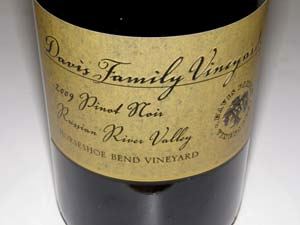 2009 Davis Family Vineyards Starr Ridge Vineyard Russian River Valley Pinot Noir 14.1% alc, 225 cases, $40. · Medium ruby color in the glass. Quintessential Russian River Valley Pinot Noir sporting aromas and flavors of Bing cherries, baking spices and cola with a moderate dose of red raspberries and red currants. Still has firm tannins that will soften over time, but the wine is very enticing now. Finishes strong with impressive mouth coating intensity and a refreshing riff of acidity. A classy wine from a mature vineyard that is now coming in to its own.
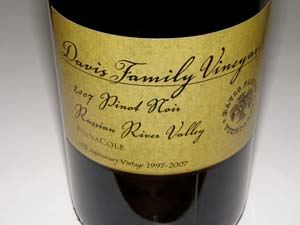 2009 Davis Family Vineyards Horseshoe Bend Vineyard Russian River Valley Pinot Noir 14.1% alc., 225 cases, $42. From a ridgetop vineyard close to the Pacific Ocean on the western flank of the Russian River Valley AVA. A cool site above the Russian River Valley fog line, creating long days of sunlight and a darker, masculine expression of Pinot Noir. · Moderate reddish-purple color in the glass. Brooding nose initially, offering dark red berry, black stone fruit, and oak-driven roasted nut and vanillin aromas. Opens slowly over time in the glass becoming glorious with the oak notes moving to the background and fresh, ripe, and spicy dark fruits coming to the foreground. Medium-weighted flavors of plum reduction sauce, black currants, raw beef and a hint of tar and oak. This wine has a unique feral attitude and an unmistakable sense of terroir that grabs your interest. Polished and seamless with soft tannins, this wine will be even more expressive with more time in the bottle.
2009 Davis Family Vineyards Soul Patch Estate Grown Russian River Valley Pinot Noir 14.1% alc., 525 cases, $42. · Moderate reddish-purple color in the glass. Pleasing aromas of black cherry cobbler, bay leaf and roasted nuts. Discreetly concentrated flavors of black cherries, black raspberries and plum with the plum singing a high note on the impressively persistent finish. Moderate ripe tannins frame the wine beautifully creating a very smooth and silky mouth feel. Will improve with cellaring. Very good.
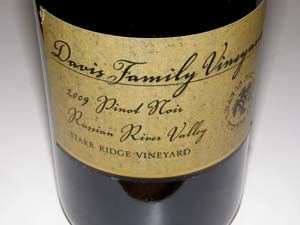 2007 Davis Family Vineyards PinnaCole 10th Annniversary Vintage Russian River Valley Pinot Noir 14.1% alc., $60. A reserve estate wine that receives an additional 6 months in barrel and 12 months in bottle. Offered to wine club and mailing list members in early September (check winery for availability). · Moderately light reddish-purple color in the glass. The nose opens very slowly to reveal a haunting mix of cherries and berries with an appealing grassy, herbal note. Delicious black cherry and black raspberry core of moderate intensity lingering on the long citrus-tinged finish. A subtle dark chocolate note adds interest. Still young and a bit tight, improving slowing in the glass over time and becoming more polished and showy the next day from a previously opened and re-corked bottle. Beautifully crafted with well-honed acidity that brightens the fruit. A little fruitier with silkier tannins than its spectacular 2006 predecessor, and every bit as charming. Decant if you must open now.
More Russian River Valley Gems
Small Vines WinesPaul and Kathryn Sloan are owners of Small Vines Viticulture, established in 1998 in Sonoma County to plant and farm ultra high density vineyards in the Russian River Valley and Sonoma Coast appellations. High density plantings are from 2722 to 3630 vines per acre. Tractor rows are typically 4 feet wide (the California average is 8 to 12 feet), and the plants are spaced anywhere from 3 to 4 feet apart depending on site and plant selection. Their underlying philosophy is that smaller vines produce diminutive and more intensely flavored grapes and by extension, higher quality wines. Their mantra is, “The smaller the vine, the better the wine.” Each vine is farmed individually using standards of only 8 shoots per meter, allowing each vine to carry only 1.5 to 3 pounds of fruit, with carefully monitoring of soil moisture, using water sparingly when necessary to improve wine quality and then only on specific vines.
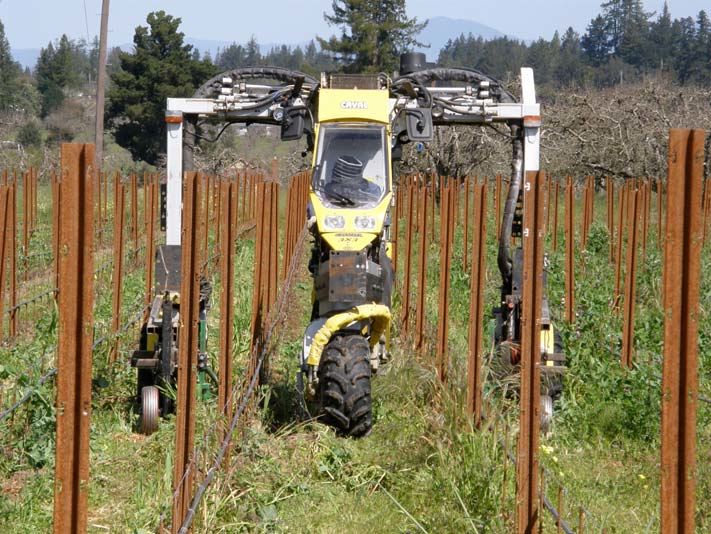 The Sloans also produce small lots of Pinot Noir, releasing their first wines in the 2005 vintage. The wines are crafted at Copain’s Custom Crush facility in Santa Rosa. They source grapes primarily from their estate vineyard (12.5 acres outside of Sebastopol with 4.5 acres of Pinot Noir, 4.75 acres of chardonnay and two thousand vines of Pinot Gouges, the white mutation of Pinot Noir found in Henri Gouges’ vineyard in Nuits-St.- Georges, all planted in 2009), MK Vineyard in the Sonoma Coast, and the Baranoff Vineyard in the Russian River Valley. Both appellation (Russian River Valley and Sonoma Coast) and vineyard-designated (MK Vineyard and Baranoff Vineyard) Pinot Noirs are offered. A minimalist in the winery, Paul Sloan believes that naturally made wines last longer and give more drinking pleasure so only natural yeasts are used and the wines are neither fined or filtered. The Sloans are very passionate and innovative young winegrowers who also craft extraordinary wines. I would suggest you join their release mailing list to guarantee access to future releases. Follow the Small Vines Blog and videos at www.smallvines.com/blog. For a tour or more information, contact Paul or Kathryn at 707-823-0886, e-mail at info@smallvines.com, or visit the website at www.smallvines.com. The wines are sold on the website and through a mailing list. Magnums, etched magnums and jeroboams are offered. Future plans call for an estate Chardonnay from the 2011 vintage.
2009 Small Vines Wines Russian River Valley Pinot Noir 14.2% alc., 386 cases, $50. · Moderately dark reddish-purple color in the glass. Deep aromas of cherries, jam on toast, and vanillin. On the palate, medium weight flavors of black cherries and cola are featured with a slight tarry, smoky accent. The tannins are nicely managed, the mid palate and finish offer pleasing intensity and the wine finishes dry and fruity. Good (+).
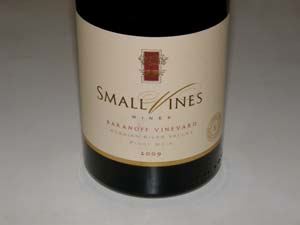 2009 Small Vines Baranoff Vineyard Russian River Valley Pinot Noir 13.9% alc., 75 cases, $65. Located on a hillside overlooking the Laguna de Santa Rosa, this vineyard also supplies grapes for the Small Vines Russian River Valley Cuvée. Mostly Calera clone with some Swan and Dijon 115 clone. 10% whole cluster. · Moderately dark reddish-purple color in the glass. Shy nose offering scents of berry jam, spice, oak cask and green garden. Tasty core of black cherry, black raspberry and plum fruit with slightly astringent tannins and a juicy, fruit-filled finish. Velvety on the palate, evolving slowly in the glass. Much more enticing the next day from a previously opened and re-corked bottle. Should be stellar in a few more years. Very good.
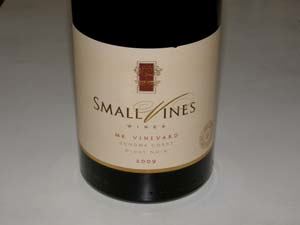 2009 Small Vines MK Vineyard Sonoma Coast Pinot Noir 13.9% alc., 150 cases, $65. 10.5 miles from the ocean, this temperate site was planted in 1999 and has been farmed organically since 2006 with added biodynamic practices since 2007. · Moderately dark reddish-purple hue in the glass. Appealing aromas of dark berry jam, black plums and oak. Lovely flavors of dark red and black Pinot fruits, building in intensity with time in the glass, and finishing with impressive grand cru persistence of aromatic black cherries. Still young, but the pedigree of the fruit really stands out and it is hard to resist now. More intensely flavored and expressive the next day from a previously opened and re-corked bottle.
Skewis WinesHank and Margie Skewis have a dedicated following for their small lots of vineyard-designated Pinot Noir from Sonoma and Mendocino counties that they have produced since 1994. Hank is a veteran of over 27 vintages, having honed his winemaking skills at Lambert Bridge in the Dry Creek region of Sonoma County before starting his namesake label. He crafts less than 1,000 cases of premium Pinot Noir from vineyard sources that have varied through the years, but have always been consistently superb.
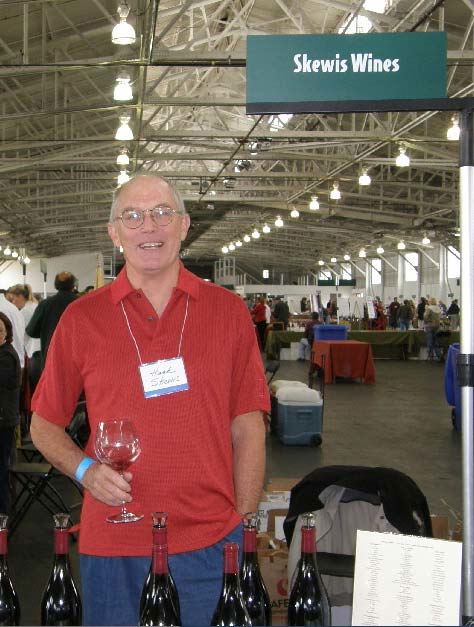 Winemaking is traditional with minimal intervention. Carefully sorted grapes are gently crushed into small bins, fermented warm, pressed into French oak barrels where primary and secondary fermentations are completed. The wines are typically aged in barrel for 18 months, racked for blending, and then racked a second time in preparation for bottling. The wines are then aged an additional 4 to 6 months in bottle before release. Skewis Pinot Noirs offer enjoyable drinking upon release and by virtue of their balance and structure, dependable age ability. I recently visited their new tasting room in the historic Roma Station Winery complex in Healdsburg. The 1997 Skewis Montgomery Vineyard Russian River Valley Pinot Noir was lean with cherry fruit starting to fade and tannin and acid coming to the forefront. Still, the wine would work nicely with food and appease the most fastidious old wine enthusiasts. The 2002 Skewis Montgomery Vineyard Russian River Valley Pinot Noir still had good color, offered lovely fruit-filled, floral aromas and flavors, and still had plenty of life for several more years of enjoyment.
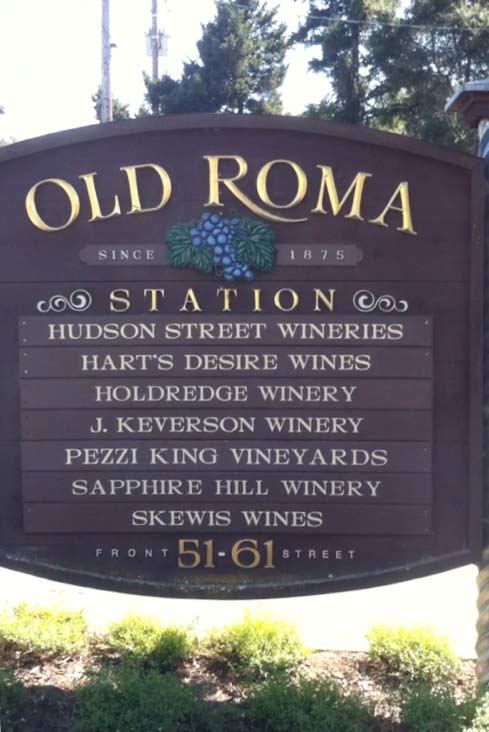 A unique feature of Skewis Wines is that the wines are offered in half-bottle sampler packs. Wines age quicker in this format, giving the taster an opportunity to taste the wines at a relatively mature stage. The wines are sold through the tasting room and a mailing list at www.skewis.com. The tasting room is open Friday - Monday 11:00-4:00 and by appointment. The website offers extensive tasting notes and an informative section on wine and food pairing. A small amount of some of the 2008 vintage wines are still available. The 2009 vintage wines tasted below continue the theme, as they are all well-crafted, soft in the mouth, and approachable now with the balance to predict long term age ability. The Ridley Vineyard Pinot Noir is the most forward of the trio.
2009 Skewis Lingenfelder Vineyard Russian River Valley Pinot Noir 14.7% alc., 120 cases, $45. 3-acre vineyard west of the town of Fulton planted in 1996 and grafted to UCD 13 (Martini clone). · Moderately intense reddish-purple color in the glass. Very reserved nose offering little fruit and primarily aromas of oak-driven mocha java. Bing cherry fruit is featured with a strong presence of mocha java flavor and herbal oak that fades over time in the glass. Very soft and seductive in the mouth. This wine is very young and currently steeped in oak which will recede over time in the cellar. Patience is advised. Good.
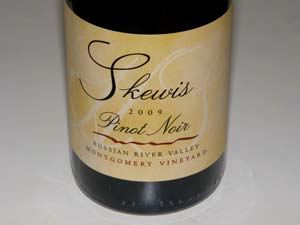 2009 Skewis Montgomery Vineyard Russian River Valley Pinot Noir 14.5% alc., 125 cases, $45. A small, 20(+)-year-old vineyard situated west of Santa Rosa in the Olivet Road area. The clone is undocumented. The area is characterized by poor clay soils and frequent summer fog. · Moderate reddish-purple color in the glass. Nicely perfumed with aromas of dark red berries and cherries, woodshed and spice. Moderately full-bodied core of black cherry flavor with a complimentary hint of oak, dusty tannins, and a dry finish. Although the nose trumps the flavors at this stage, the flavors grow on you over time in the glass. Very good.
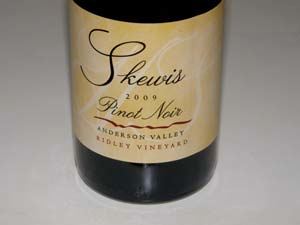 2009 Skewis Ridley Vineyard Anderson Valley Pinot Noir 14.8% alc., 125 cases, $42. 3 acres of clone 777 at a low elevation adjacent Boonville. · Moderate reddish-purple color in the glass. Nose-filling aromas of cherries, strawberries, baking spices and sandalwood. Delicious essence of red cherry and red berry fruits, nicely spiced and framed by sturdy tannins. The purity of the fruit really catches your attention, grabs hold, and clings through the finish which seems to last an eternity. A restrained, elegant wine that is smooth and seductive in the mouth. A winegasm.
Ketcham EstateMark Ketcham was a “greenhorn” farmer when he acquired 17 acres off Eastside Road in the upper neck region of the Russian River Valley. Born in Palo Alto, he had a small successful tech company, allowing him to spend two to four months each year over a seventeen year period racing vintage cars in Europe. Mark retired from the tech company in 1998 and began to seek a second home. He looked both at Del Monte Forest in Monterey County and Northern California wine country, and after considering over 120 properties, settled on a Russian River Valley estate that had a moderate size vineyard and a 5,000 square foot ranch house that Mark describes as “ugly and pedestrian.” The site, however, was well situated for winegrowing, benefiting from cool mornings and evenings and a marine breeze each afternoon that moderated the heat. Mark saw potential in the property. The previous owners had been selling their Chardonnay and Pinot Noir crop to Gloria Ferrer Winery for ten years and receiving $1,800 per ton for Chardonnay and $2,300 per ton for Pinot Noir that was cropped at 8 to 10 tons per acre and picked early for sparkling wine. When he assumed ownership of the property in 2000, the vineyard management company assured him that Gloria Ferrer Winery would continue to purchase the grapes despite the absence of a written contract. By August, Mark had not heard from Gloria Ferrer Winery, and when he finally contacted them, he was to discover that they had more estate fruit coming on line and had no further interest in Mark’s grapes. Mark was now panicky. A winegrowing friend in Sonoma told him that the demand for grapes was low and that wineries were not returning his inquiring phone attempts to sell grapes. Undaunted, Mark began calling around and found the wine community very collegial, referring him to others when they had no interest in the grapes. Finally, Kendall-Jackson (specifically La Crema) consented to take the crop. They agreed to pay $1,200 per ton for the Chardonnay and $1,800 per ton for the Pinot Noir, but demanded that he drop a significant amount of the crop. The favorable weather in 2000 allowed an extended hang time, and the grapes were finally harvested in October. For two years, Ketcham Estate grapes went into La Crema’s ultra-premium 9-Barrel program. Mark likes to say his rocky introduction to winegrowing benefited him (“When you close one door, another door opens.”). In his search for suitors for his grapes, he made many contacts in the Sonoma County community that would serve him well over the ensuing years. In 2002, Mark ripped out the 5 acres of planted Chardonnay and most of the vineyard’s Pinot Noir, leaving 1.5 acres of relatively old (25 to 30 years) Pommard 4 clone Pinot Noir. He then planted 12 acres of Pinot Noir (Pommard and Dijon 115, 667, 777 and 828) on two rootstocks. His goal was to focus solely on Pinot Noir and produce his own wine from the property. Together with initial partner Steve Rigisich (an organizer of Pinot Days), the first 50 cases of Ketcham Estate Pinot Noir were produced at Crushpad in 2004. The first real commercial wine appeared in 2005, when Mark’s friend, noted winemaker Michael Browne, agreed to vinify the Ketcham Estate Pinot Noir. Browne was to remain in charge for three vintages. With the 2007 vintage, two Ketcham Estate Pinot Noirs were released: a Russian River Valley blend of all clones on the estate vineyard except the “old vine” Pommard combined with a small amount of purchased grapes, and a Ketcham Estate Vineyard Pinot Noir composed of all clones on the property including the “old vine” Pommard. In 2008, Scott Rich (owner and winemaker at Talisman) crafted the 2008 vintage of Ketcham Estate Russian River Valley Pinot Noir and the Ketcham Estate Vineyard Pinot Noir. In 2009 and 2010, Rich continued to make the Russian River Valley bottling and a “famous winemaker on Westside Road,” whose name must remain anonymous, vinified the Ketcham Estate Vineyard Pinot Noir. Mark has sought a style of Pinot Noir that is typical for California with moderate alcohols (14.0%-14.5%), early appeal, but with the balance and structure to age. Although he is not the winemaker, he takes a serious interest in the winemaking process and participates in all the blending decisions. The Ketcham Estate Vineyard Pinot Noir is aged 16 months in 100% new French oak and the Ketcham Estate Russian River Valley Pinot Noir is aged 16 months in 36% new and 30% 1-year-old French oak. Happy with his life choice, Mark has settled into the life of a farmer in Healdsburg (or “Beverly Healdsburg” as some have called this bucolic community of many well-to-do winegrowers). He grows 26 kinds of heirloom tomatoes, two types of heirloom corn, walnuts, apples, tomatillos and peppers on his property. The original house was torn completely down leaving only the existing fireplace and reconstructed to his taste over three years. Ketcham Estate Pinot Noirs are sold primarily through a mailing list at www.ketchamestate.com, but are also sold directly through the website store. There is some retail distribution in the United States. Future plans call for a Russian River Valley Chardonnay. Production of Pinot Noir has gradually increased, with 13 barrels of the Ketcham Estate Vineyard Pinot Noir available in 2010. Mark is now the sole owner of the winery. The 2009 vintage Pinot Noirs reviewed below were bottled in May 2011. The wines were sampled both at Mark’s home and the following day from previously opened and re-corked bottles.
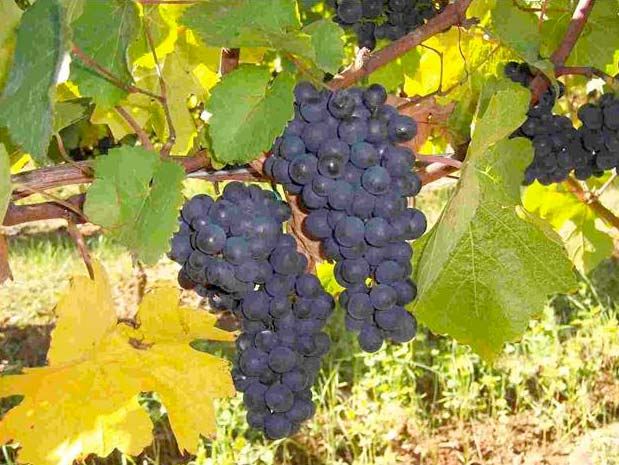
2009 Ketcham Estate Russian River Valley Pinot Noir 14.5% alc., 901 cases, $38. · Moderate reddish-purple color in the glass. Enticing aromas of well-spiced Bing cherries and rose petals. Soft and elegant on the palate, with moderately dense flavors of black cherries, Hoison sauce, and cola, enrobed in fine-grain tannins, leaving a little heat in its wake on the moderately long finish. Good.
 2009 Ketcham Estate Vineyard Russian River Valley Pinot Noir 14.1% alc., 189 cases, $48. Clones are Pommard, 777 and 828. Aged 16 months in 100% new French oak. · A shy nose initially that offers more cherry fruit intensity over time in the glass. Subtle aromas of seasoned oak and underbrush add interest. Impressive mid palate attack with striking black cherry and black raspberry fruit offering impressive persistence on the fruit-filled ending. More structure, tannin and intensity than the Russian River Valley bottling yet a very polished wine that is soft in the mouth. The oak is nicely integrated. Should improve with another year or two in bottle. Very good (+).
Some Current Russian River Valley Appellation OfferingsAppellation bottlings often take a back seat to the more expensive and often over-hyped vineyard designate wines. Some wineries produce appellation blends as almost an afterthought, throwing in all the inferior leftover juice after the best barrels are chosen for the single vineyard program. Others, take the opposite approach, blending the appellation wine initially before barrels are chosen for single vineyard designation. Most vintners follow the tact of Adam Lee at Siduri Wines. After each of the barrels in the cellar age for at least six months, tasting ensues to determine the several different desired blends. The favorite blend becomes the single-vineyard Pinot Noir. The final number of barrels chosen for the final blend can vary considerably. The barrels that don’t fit in to the single-vineyard blend are assigned to the appellation wines. These wines are blended with wine from other vineyards in the same appellation. The common assumption is that the barrels that do not make the single-vineyard blend cut are inferior and a blend of these barrels from different vineyards would also be inferior. This is not necessarily the case. Certain barrels may not be strictly reflective of a vineyard’s terroir, but that does not mean that the wine isn’t desirable. Some consumers will prefer the final appellation wine. Legally, at least 85% of the grapes in an appellation-designated wine must come from that appellation. 95% of the grapes from a single vineyard wine must originate in the designated vineyard wine. Appellation-designated Pinot Noir can be a great value, invariably priced less than the more prestigious single-vineyard wines. Siduri Wines is a perfect example. All the 2008 Siduri Wines appellation blends (Chehalem Mountains, Russian River Valley, Sonoma Coast and Sta. Rita Hills) are priced at $30, while the vineyard-designated wines are priced at $48 and above. I preferred the 2008 Siduri Wines Sta. Rita Hills appellation Pinot Noir over some of the Siduri Wines vineyard designates. Sadly, several of the appellation wines reviewed below do not offer the quality that one would expect at the offered price levels.
2009 Arista Russian River Valley Pinot Noir 14.3% alc., 739 cases, $44. · Moderately light reddish-purple color in the glass. Ripe and slightly confected dark stone fruit and berry aromas with a slight oak-driven spice and smoke accent. Modestly weighted deep red cherry and berry flavors that are slightly cooked, exhibiting silky tannins, finishing a tad dilute and short. Not as enjoyable as the bottle reviewed over two months ago. Decent.
2009 Brogan Cellars Russian River Valley Pinot Noir 14.8% alc., $50. · Darkly colored in the glass. Aromas and flavors veer to the very ripe side with notes of black plums, black currants, dried blueberry, prune, raisin and oak. A somewhat unpleasant tarry bent is evident. A full-throttle, big and burly wine finishing with hipitched acidity. Decent.
2008 Conspire Russian River Valley Pinot Noir 14.4% alc., $40. Crafted by Napa Valley winemaker Amy Aiken. · Moderately deep reddish-purple color in the glass. Aromas of dark red cherries, strawberries, subtle spice, “automobile garage,” and smoky oak. Medium-weighted flavors of cherries, black raspberries and strawberries with an underlying smoky, tarry note. Fresh and clean with soft tannins and lively acidity. I am not a fan of smoky Pinot, but there are consumers who seem to enjoy it and they may welcome this wine. For me, the smoky, burnt flavors simply tarnish the pretty fruit in this wine, although they tend to diminish over time in the glass. Tasted twice a few months apart. Unsatisfactory.
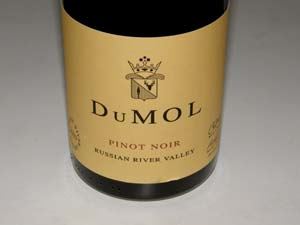 2009 DuMOL Russian River Valley Pinot Noir 14.3% alc., 3,900 cases, $64. Sourced from seven cool vineyards located on the western edge of the Russian River Valley. Clones are Old Beringer, Dijon 114, 115, 667, 777, Calera, Swan and Pommard. Vine age 5 to 24 years. Aged 11 months in 40% new French oak barrels. Unfined and unfiltered. · This wine was a revelation. Moderately deep reddish-purple color in the glass. Lovely, demure aromas of dark red cherries and berries and brioche. Sinfully delicious with intense, sweet flavors of black cherries, spice and Hoison sauce. Polished and classy, seductively silky on the palate, with suede tannins and perfect integration of oak, ending with a juicy finish that lures you back to the glass. Impeccable balance. I gave my wife a taste and she grinned from ear to ear. Everything you could ask for in a Russian River Valley appellation Pinot Noir and worth every penny. Look for this wine on my 2011 All- American list.
The DuMOL Russian River Valley appellation blend is composed of 21 separate fermentation lots of free run wine only. All lots are harvested, fermented and barreled individually. Average Brix at harvest 24.6. A selection is made in July and racking and blending from barrel is done immediately pre-harvest in early September to holding tanks. The final blend settles naturally in the tanks for 3 months before bottling in December. During these 3 months, Andy says the wine harmonizes and achieves microbial stability. The finished wine contains the more fruit-driven and concentrated lots while the more backward and structured lots go into the DuMOL vineyard-designate wines. The wine spends 11 months in barrel, 3 months in tank, and 6 months in bottle before release. Approximately 70% of the appellation wine goes to the winery's mailing list and the balance to the market, primarily restaurants. The concentration of the fruit in the DuMOL Russian River Valley Pinot Noir is striking and I asked Andy about this. He replied, “Our reputation for making 'over sized' wines is an old misconception based on the 2003 and 2004 vintage wines that were the result of tough, hot years. I don't know anyone in the Russian River Valley that picks earlier than us except maybe Kistler since 2009. It is just that we do much more vineyard work so the grapes are naturally more concentrated....something for which I will not apologize for!”
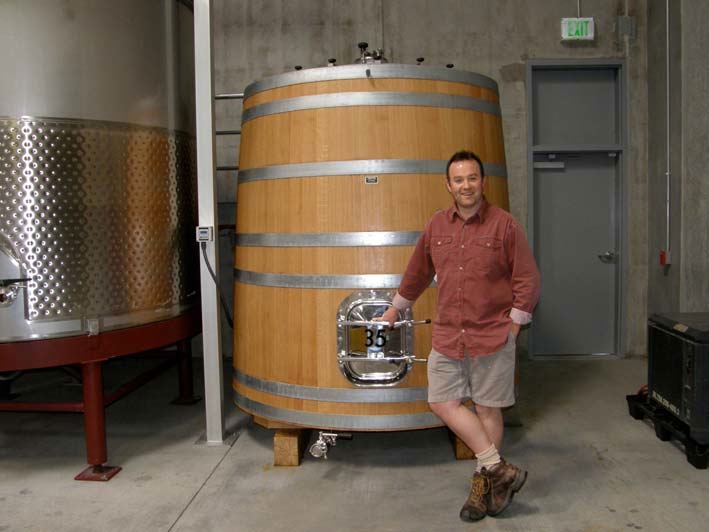
2008 Merry Edwards Russian River Valley Pinot Noir 14.3% alc., $60. · Moderate ruby color in the glass. Reduced aroma initially with prominent oak char opening up slowly in the glass to reveal pleasing scents of Bing cherries and spice. Full-bodied core of black cherries, black raspberries, brown spice and cola. More darkly fruited than many Russian River Valley Pinot Noirs. A Cabernet drinker’s Pinot with sturdy tannins, modest acidity, and dense, very ripe fruit. The wine had roasted fruit aromas and marked black currant and porto flavors the following day from a previously opened and re-corked bottle. Not my cup of tea. Decent.
2009 Pellegrini Family Vineyards Olivet Lane Vineyard Russian River Valley Pinot Noir 14.4% alc., $28. · Moderately light reddish-purple hue in the glass. A mix of red and black stone fruits and berries on the nose and palate with an underpinning of earth, anise and leaf, reflecting nicely this unique terroir and clonal combination. Soft in the mouth, finishing with a dry, mildly tannic finish. More enticing over time in the glass. Good (+).
Bailiwick: Very Impressive NewcomerOccasionally a new producer seemingly comes out of nowhere and really grabs my attention. Four bottles of 2009 Bailiwick Pinot Noir recently showed up on my wine locker doorstep with no explanation attached. I was drawn to the attractive labels and the interesting sources for the wines. All the wines turned out to be stellar: it was like a gift from heaven. After consulting the website, I found that brothers Paul and Bryan Vais, natives of the San Francisco Bay Area, are the founders and vintners. They have been making wine in their basement and various garages for 25 years, gradually acquiring the knowledge to launch a commercial venture. They had successful careers in engineering, high technology and finance, but longed to enter the wine business. In 2009, they founded Bailiwick Wine Company, intent on sourcing premium grapes from specially chosen vineyards across multiple appellations. Their Pinot Noir winemaking regimen is as follows. Grapes are harvested before dawn, hand sorted at the winery, and 100% de-stemmed without crushing. A short cold soak in small open top fermenters is followed by inoculation of yeast. Punch downs are performed 2 to 3 times a day. Post-fermentation maceration is performed and the wine is pressed off into French oak barrels. The wines are racked once before bottling after spending 17 months in 20%-50% new French oak cooperage, appropriately matched to the fruit source. Four 2009 Pinot Noirs and a 2010 Vermentino are the inaugural Bailiwick offerings. The Pinot Noirs are impressive inaugural releases, displaying deft winemaking. The wines are bright and uplifting with modest alcohol and welcoming acidity, making them easy to recommend. The owners are foodies and this shows in the suitability of their wines for the dinner table. Visit the well-organized website at www.bailiwickwines.com where the wines are available for purchase.
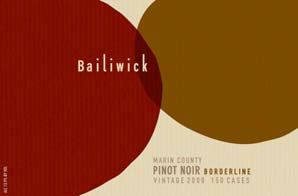 2009 Bailiwick Borderline Marin County Pinot Noir 13.9% alc., pH 3.52, TA 0.62, 150 cases, $34. Sourced from Chileno Valley and Kendric vineyards in the Marin County AVA. Chileno Valley Vineyard is farmed by Mark Pasternak (owner of Devil’s Gulch Ranch and Vineyard) and Kendric Vineyards is managed by Stewart Johnson (Kendric Vineyards wines). Swan selection, Dijon and Pommard clones. Aged 17 months in 44% new French oak barrels. · Moderately light reddish-purple color in the glass. Nicely perfumed with cherries, strawberries, spice and dried rose petals. Red-fruited, featuring lighter-weight flavors of cherries, raspberries, sandalwood, baking spice, leaf and tobacco. Crisp, with good acidity and polished fine-grain tannins. Very good.
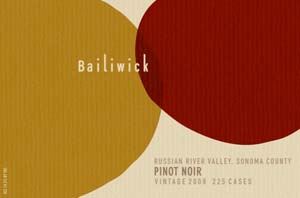 2009 Bailiwick Russian River Valley Pinot Noir 14.2% alc., pH 3.58, TA 0.64, 225 cases, $36. 57% Maurice Galante Vineyard located in the Green Valley of Russian River Valley and 43% O’Neel Vineyard situated in the Santa Rosa plain. Clones are 115, 777 and Pommard. Aged 17 months in 20% new French oak barrels. · Moderately light reddish-purple hue in the glass. Enticing aromas of dark red cherries, berry jam on toast and wooded forest. Medium-weighted flavors of fresh cherries, cola, and leaf framed by soft tannins and bright acidity, finishing with some persistence on the pleasing finish. Not impressive on the attack, but leaves a good impression. Good (+).
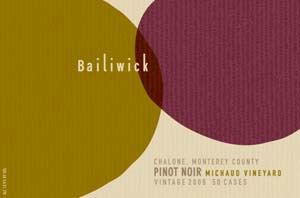 2009 Bailiwick Michaud Vineyard Chalone Monterey County Pinot Noir 13.9% alc., pH 3.68, TA 0.62, 50 cases, $44. This vineyard is situated at 1,500 feet above the Salinas Valley floor at the front door of the Pinnacles National Monument. Decomposed granite and limestone create a soil profile ideal for Pinot Noir. Farmed by noted winemaker and winegrower Michael Michaud, the masterful vintner behind some of the memorable Chalone Pinot Noirs of the 1980s. Aged 17 months in 50% new French oak. The microclimate is challenging, offering little rainfall and extreme diurnal temperature variations. Crop yields are painfully low. · Moderate reddish-purple color in the glass. Nicely endowed perfume of blackberries, plum reduction sauce and Herbs de Provence. Delicious black raspberry and blackberry core that is intense on the attack, finding every nook and cranny in the mouth, and persisting on the earth-kissed, chocolaty finish. Clean and pure, with bold tannins that are typical for this vineyard. Very good (+).
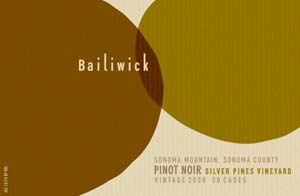 2009 Bailiwick Silver Pines Vineyard Sonoma Mountain Pinot Noir 13.7% alc., pH 3.63, TA 0.63, 50 cases, $44. This vineyard is located at 900 feet elevation overlooking Bennett Valley on the northwestern flank of Sonoma Mountain. Clone 115 planted in 2000 by owners Norm and Carole Silverman. Loamy-clay soil is low in vigor, naturally limiting yields to about 2 tons per acre. Aged 17 months in 30% new French oak barrels. · Moderately light in color. The nose is redolent of fresh berry jam, spice box and subtle oak that really draws your attention. Sinfully delicious flavors of fresh-picked dark red berries with a complimentary oak (vanilla, coffee) underpinning, leaving an impression on the vibrant and dry, berry-relish toned finish. A charming wine that combines power with finesse. My tasting notes say, “Wow,” and that clearly sums it up.
More Pinot Surprises
Chanin Wine CompanyGavin Chanin studied under Jim Clendenen at Au Bon Climat and Bob Lindquist at Qupé. He worked his first harvest at the age of eighteen at Au Bon Climat, and three years later made his first wine. After acquiring winemaking experience in New Zealand and South Africa, he started Chanin Wine Company, crafting wines in the same facility in Santa Maria that houses Au Bon Climat and Qupé, and, also working as the assistant winemaker for both labels. Chanin wines reflect the influence of Gavin’s uncle, Tony Chanin, as well as Jim Clendenen. Tony Chanin was one of the original founders of Zaca Mesa Winery in 1978 and Gavin grew up tasting the classic wines of Europe drawn from his uncle’s extensive wine cellar. As a result, he looks to the more classic style of Pinot Noir in his own style. Grapes are pick relatively early to limit the alcohol and preserve the expression of terroir, and the resulting wines emphasize elegance and restraint. Gavin graduated Phi Beta Kappa in 2009 from University of California Los Angeles with a major in art, and his artistic talents are on display on the Chanin labels which are impressive works of art. Chanin Wine Company offerings are available through a mailing list with some retail distribution. Visit the website at www.chaninwine.com. A Pinot Noir and Chardonnay from Le Bon Climat Vineyard is also offered.
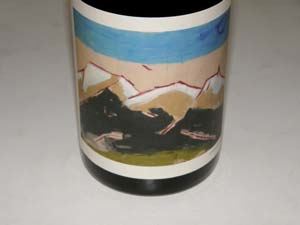 2009 Chanin Wine Company Los Alamos Vineyard Santa Barbara County Chardonnay 13.4% alc., 150 cases, $30. · Light straw color and clear in the glass. Fresh and vivid aromas of apples, baked pear, sawdust and fresh brioche. Bright, crisp and juicy flavors sing the same tune ending with a lively and refreshing citrus-imbued finish. The wine keeps pumping out charm over time in the glass. An excellent food wine that is all you can ask for in a California Chardonnay. I ran out and bought a half case.
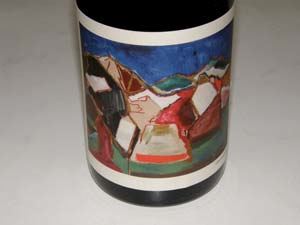 2008 Chanin Wine Company Bien Nacido Vineyard Santa Maria Valley Pinot Noir 12.9% alc., 200 cases,, $50. · Moderate reddish-purple color in the glass. Aromatically intense with well oaked, crushed cherry perfume. Lighter in weight and red fruited with supportive oak in the background. Simple and straightforward with soft tannins and a lingering cherry-driven finish. A wine for those that embrace oak and prefer delicacy and restraint. Good (+).
Castello di AmorosaThis winery offers surprisingly stellar Pinot Noir from a highly commercial, well-known tourist destination in the Napa Valley. Castello di Amorosa specializes in Super Tuscan blends, Cabernet Sauvignon, Pinot Nero (Italian for Pinot Noir), and other Italian style wines using red grapes grown in the Napa Valley adjacent the winery. Pinot Noir is sourced from the Santa Lucia Highlands, Sonoma Coast and Anderson Valley, and white grapes are grown in Napa Carneros and the Anderson Valley. The spectacular Tuscan-style Castle and Winery in the hills above Napa Valley is owned by Dario Sattui, a fourth generation winemaker. The medieval inspired castle dates to the 13th century in architecture and offers imposing towers. Wine Club events, food and wine pairings, weddings and private promotional events are held in the Castle. Various tastings are available daily, tours are offered mornings on weekdays, and horse drawn vineyard tours are available.
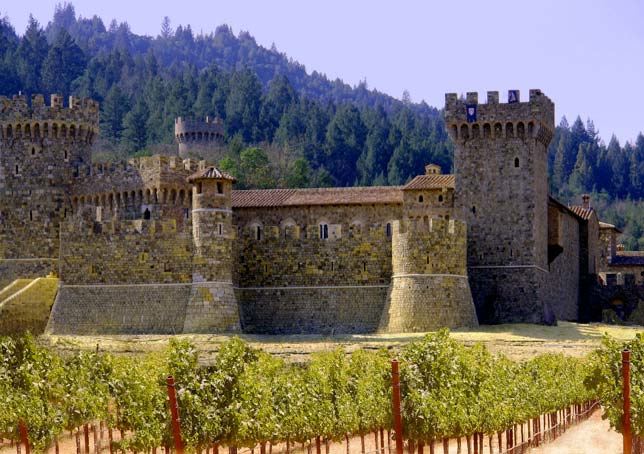 The Director of Winemaking (for both V. Sattui Winery and Castello di Amorosa) since 2005 is veteran Brooks Painter who is also a partner and winemaker for Coho, an excellent source of Russian River Valley and Los Carneros Pinot Noir. In the past, he has been the Winemaking Operations Manager at Robert Mondavi Winery in Oakville and Assistant Winemaker/Grower Relations Manager and Quality Control Manager at Stag’s Leap Wine Cellars. His writings have been published in many prestigious wine journals. The Castello di Amorosa Pinot Neros are bold expressions of Pinot Noir that are very well crafted, showing the structure and balance to last in the cellar. The wines are sold online at www.castellodiamorosa.com and at the Castle and Winery.
 2009 Castello di Amorosa Pinot Nero 14.6% alc., $36. 65% Anderson Valley grapes and 35% Santa Lucia Highlands grapes. · Moderate reddish-purple color in the glass. Open and forward aromas of black cherries and humus. Tasty essence of black cherries with hints of praline and cola. Plenty of upfront charm with well proportioned, sturdy tannins and bright acidity on the uplifting finish. Solid the next day from a previously opened and re-corked bottle. Very good.
 2009 Castello di Amorosa King Ridge Vineyard Sonoma Coast Pinot Nero 14.3% alc., $59. · Moderately dark reddish-purple color in the glass. Slight reduction upon opening, revealing aromas of black cherries, charcoal and oak over time. Lovely black raspberry and black cherry fruit with an earthy, loamy underpinning. A medium-weighted, richly flavored wine with serious intentions that still has some grippy tannins and toasty oak on board. Spectacular the next day from a previously opened and re-corked bottle. A superb candidate for the cellar.
Three Sticks Durell VineyardI recently had the opportunity to sit down over dinner with Bill Price, an investor in several wine ventures over the past twenty years including Chateau St. Jean, Kistler Vineyards and Kosta Browne. In 2002, he founded Three Sticks, a winery devoted to creating wines from the renowned 200-acre Durell Vineyard and small lots of wines from other exceptional vineyard sites. Ed Durell first planted his vineyard in 1979 on a cattle ranch in the foothills of Sonoma Valley due west of the town of Sonoma, surrounded by the foothills of the Mayacamas Mountains. He enlisted a family friend, Steve Hill, to plant and tend the grapes on the ranch and Durell began selling grapes to Sonoma County wineries in 1982. Bill and Ellie Price (Bill's former spouse) bought Durell Vineyard in 1997. The couple had a very amicable divorce, with each assuming control of a portion of the Durell Vineyard, while still working together. Bill's portion is currently under the holding title of Price Family Vineyards and Ellie's part is held by Sand Hill Wines LLC. Ellie Phipps Price previously produced Durell Vineyard Pinot Noir and Chardonnay under the Sand Hill at Durell Vineyard label, replaced in the 2008 vintage with Pinot Noir and Chardonnay from the 8.5-acre Ranch House Block of the vineyard under the Dunstan label. Ellie Phipps Price total holdings include 60 acres of the Carneros portion of the vineyard (36 acres of Pinot Noir and 15 acres of Chardonnay). Bill Price owns 130 acres of Durell Vineyard in the Carneros, Sonoma Valley and Sonoma Coast portions of the vineyard, planted to Chardonnay (75 acres), Pinot Noir (23 acres), a tiny amount of Syrah, and Cabernet Sauvignon. Due to its unique location, the 400 acres of land on which Durell Vineyard is situated has vines in three different appellations: Carneros, Sonoma Coast and Sonoma Valley. The rocky soils and cool climate are ideal for Chardonnay and Pinot Noir, with the 2,400 foot Mayacamas Mountains range sheltering the vineyard from the daily maritime winds originating from the San Francisco Bay, just ten miles to the south. The 59 acres of Pinot Noir in the Durell Vineyard includes Dijon clones 114, 115, 667, 777, 828 as well as some Swan and Calera selections. Steve Hill managed the entire vineyard until the beginning of 2011 when Rob Harris took over as vineyard manager. Steve Hill continues to work with Bill on other vineyard acquisitions. The Durell Vineyard has been the source of Chardonnay, Pinot Noir and Syrah for many noted wineries and currently sells grapes to 27 wineries, among them Auteur, Chasseur, Chateau St. Jean, Dunstan, Kistler Vineyards, Lioco, Loring Wine Co., Pali Wine Co., Sand Hill, Saxon Brown, Steele and Three Sticks. Frequently, Durell Vineyard is designated on the label. Kistler Durell Vineyard Chardonnay has been a benchmark California Chardonnay for many years. The winemaker for Three Sticks Wines is Dan Van Staaveren, the former winemaker of Chateau St. Jean (1985 to 1997), Sand Hill and Dunstan. Kenneth Juhasz became the winemaker for Dunstan after the 2010 vintage. In September 2011, I attended a Three Sticks Durell Vineyard wine dinner at Gordon Ramsay at The London West Hollywood. This was an opportunity to sample three vintages of Durell Vineyard Sonoma Coast Pinot Noir, the recently released 2009 Durell Vineyard Sonoma Coast Chardonnay, the 2008 “The James” Sta. Rita Hills Pinot Noir, and three vintages of Sonoma Valley Cabernet Sauvignon. I do not have extensive tasting notes on the wines served at dinner but can make the following general comments. The 2009 Three Sticks Durell Vineyard Chardonnay is a mix of Wente and Dijon clones aged in 50% new French oak barrels and 20% in cement egg fermenters. A classic Chardonnay with aromas and flavors of butterscotch, creme brulee, honey, pear and citrus, along with well-integrated oak and crisp acidity. Balance is spot on for this sophisticated offering. The 2004 Three Sticks Durell Vineyard Pinot Noir was vinified by winemaker Jeff Gaffner. The wine has held up nicely, crafted in a full-bodied, extracted style with very ripe flavors including raisin. The 2006 Three Sticks Durell Vineyard Pinot Noir and the 2008 Three Sticks Durell Vineyard Pinot Noir are moderately rich and more elegant in style with judicious use of oak and show the soft texture that is Pinot’s calling card. The 2007 vintage has been previously reviewed in this newsletter. The 2008 Three Sticks “The James” Sta. Rita Hills Pinot Noir is sourced from Burning Creek Vineyard. Only 120 cases produced. Very aromatic with bright cherry and berry flavors framed by lively acidity. Promiscuous and hard to take your hands off this one. The 2005, 2006 and 2007 Three Sticks Sonoma Valley Cabernet Sauvignons are beautifully crafted wines showing the deft touch Dan Van Staaveren has with this varietal. The 2007 vintage, recently released, is a dreamy wine that only hints now at its potential. Three Sticks Wines is one of the few wineries in California to succeed with the trifecta: Pinot Noir, Cabernet Sauvignon and Chardonnay. The superb quality of the portfolio of Three Sticks wines is easily understandable: relatively old vine vineyard farmed by a highly respected long time vineyard manager, a talented, veteran winemaker, and management with years of experience in the wine business. Three Sticks wines are sold through an allocation list due to the small production. Visit the website at www.threestickswines.com to sign up for the mailing list.
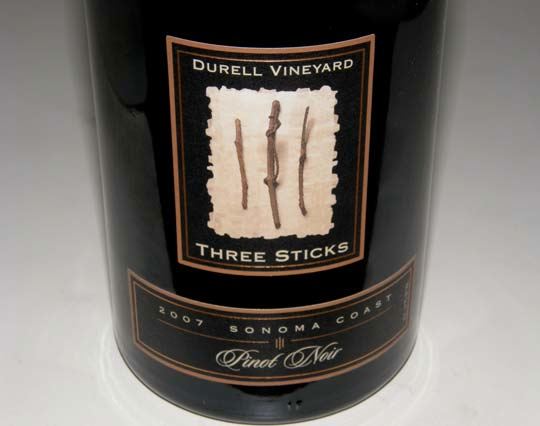
Plenty of Oregon ’08 and ’09 Pinot Bounty in the Marketplace Oregon
Amalie Robert EstatePartners Ernie Pink and Dena Drews bought a cherry orchard 15 miles southwest of Salem, Oregon, and began converting the property to a vineyard in 1999. The couple were Pacific Northwest computer geeks who had no background in the wine business, but learned winemaking and viticulture through local community college courses. The 30-acre dry-farmed vineyard is planted primarily to eleven clones of Pinot Noir, with lesser amounts of Pinot Meunier, Syrah, Chardonnay and Viognier. Elevation ranges from 275 to 650 feet and the soils are welldrained Bellpine series. The first vintage in 2002 was sold to several notable Willamette Valley wineries (including Beaux Freres and Cristom). By 2006, a gravity-flow winery was completed and the owners had bottled their first vintage under the Amalie Robert label. The name is a combination of the proprietors middle names: “Amalie” (AIM-a-lee) is Dena’s and “Robert” is Ernie’s. Their rapid ascent into the upper echelon of Oregon Pinot Noir producers has been remarkable, and this year the winery is one of a group of forty-two select Oregon wineries participating in The Vintner’s Circle at the ¡Salud! Oregon Wine Auction. The winery was a chosen participant in this year’s International Pinot Noir Celebration and was selected by Wine & Spirits as a 2011 Winery of the Year. With only three vintages of Pinot Noir in the marketplace, that is quite an accomplishment! Amalie Robert Estate wines are sold through the winery’s online store. Magnums of some wines are offered by request. Tasting is by appointment. Visit the interesting and somewhat quirky website and read about how the proprietors found their Pinot Noir groove (hint: it involved a magnum of Domaine Dujac drank with a meal in Paris). Mailing list members receive a yearly Julian Calendar to track the growing season. This monthly update includes both a photo journal and farming humor and I find it thoroughly captivating. I recently sampled the lineup of 2008 Amalie Robert Estate Pinot Noirs and a 2009 Amalie Robert Estate Chardonnay. This was my first exposure to this winery and I considered the wines well-crafted with admirable balance and charm. The Pinot Noirs are fermented with whole clusters and indigenous yeast. All Pinot Noirs are aged a minimum of 12 months in French oak barrels. The lineup of wines is based on barrel selections. The two partners independently select their favorite barrel for The Reserve (not tasted here). They then choose the “Hers” and “His” reserves: Amalie’s Cuvée and Estate Selection. About 10 to 15 barrels are selected that represent their individual palates. The Vintage Debut is the first Pinot Noir release from the vintage, reflecting the broadest interpretation of the vineyard terroir and crafted for early drink ability. The Wadenswil Clone and Dijon Clones bottlings speak for themselves. Both a stainless steel fermented Chardonnay (Her Silhouette) and barrel fermented Chardonnay (Heirloom Cameo) are offered.
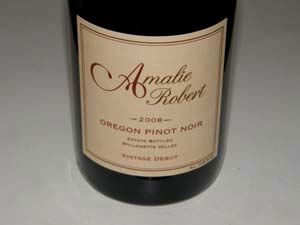 2008 Amalie Robert Vintage Debut Estate Bottled Oregon Pinot Noir 13.4% alc., $30. · Moderate reddish-purple color in the glass. Nicely perfumed with vivid aromas of black cherries, spicy stem, and new oak. Light to medium weight flavors of black cherries and red berries with complimentary oak. Supple tannins and brisk acidity on the finish. Nicely put together and very approachable now. I like it for its easy drinkability. Drink this one while you cellar the other 2008 Amalie Estate Pinot Noirs. Fine the next day from a previously opened and recorked bottle indicating it will hold up nicely over the next few years. Very good.
2008 Amalie Robert Amalie’s Cuvée Estate Bottled Oregon Pinot Noir 13.8% alc., $50. · Moderate reddish-purple color in the glass. Complex nose offering aromas of cherries, strawberries, sandalwood, wine cellar, balsam and a little barnyard. The pleasing core of fresh cherries makes quite an impression on the mid-palate and persists on the long finish that is marked by sharp citrus-driven acidity. Flavors of new oak and tobacco ply the background. An elegant, vibrant and minerally wine that is ready to drink now. Good (+).
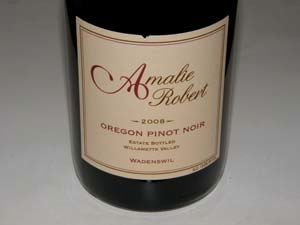 2008 Amalie Robert Estate Selection Estate Bottled Oregon Pinot Noir 13.8% alc., $50. · Moderate reddish-purple hue in the glass. Subdued but pleasant aromas of mixed berries and black cherries with a violet note. Silky and earth-driven flavors of darker red berries and subtle baking spice, wrapped in supple tannins with oak playing a complimentary role in the background. A classy wine with very impressive persistence on the aromatic finish. The most cellaring potential of the 2008 Amalie Robert Pinot Noirs and the one with the most Pinot charm.
2008 Amalie Robert Dijon Clone Estate Bottled Oregon Pinot Noir 13.4% alc., 192 cases, $40. Dijon clones 777 (72%), 115 (23%) and 667 (5%) grown on 3 different rootstocks sourced from 5 dry-farmed blocks. · Medium reddish-purple hue in the glass. A chameleon in the glass with mellow aromas that come and go including cherries, strawberries, brier, herbs and spice. Simple and direct, medium-bodied essence of cherries and cherry skins on the palate, finishing on a cherry and citrus high note. A pretty wine that aims to please. Very good.
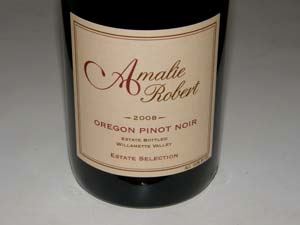 2008 Amalie Robert Wadenswil Estate Bottled Oregon Pinot Noir 13.8% alc., 50 cases, $50. · Moderate reddish-purple color in the glass. Complex scents of black cherries, blackberries, sassafras, prickly pear and oak vanillin. Darkly fruited and savory, mysterious and primal, offering flavors of black currants, blackberries and brown spices enrobed in dusty, fine-grain tannins. More intrigue and structure and less acidity than the Dijon Clones bottling. A good cellar candidate. Very good (+).
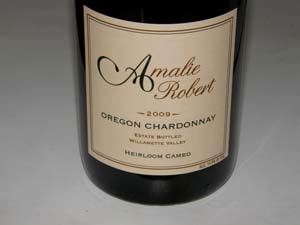 2009 Amalie Robert Heirloom Cameo Estate Bottled Oregon Chardonnay 14.5% alc., 80 cases, $50. Two-thirds Dijon clone 76 and one-third Dijon clone 95. I haven’t tasted many Oregon Chardonnays, but I do taste quite a few California Chardonnays, and this wine made quite an impression on me. If this wine is indicative of Oregon’s potential for Chardonnay, more Oregon wineries should feature this varietal. Although I enjoy Pinot Gris for what it is and understand it is Oregon’s signature white wine, Chardonnay can potentially offer more sophisticated drinking. · Light straw color and clear in the glass. Enticing aromas of white peaches, lemon curd, white pears and buttery oak. Delicious and juicy array of white peach, Asian pear, baked apple and pineapple flavors, honed with just the right amount of mineral-driven acidity for brightness, and offering a silky mouth feel that excites the senses. A classic, and maybe the best Oregon Chardonnay I have ever had.
Domaine Drouhin OregonThis iconic producer needs no introduction. Véronique Drouhin-Boss has crafted the wines here in every vintage beginning in 1988. The Pinot Noirs show more elegance and less power than many Oregon Pinot Noirs, and they age extremely well. I have had a couple bottles of the 1992 vintage within the last two years, and the wines are still remarkably fresh. If you had to choose just one Oregon Pinot Noir producer that represents the Oregon style and differentiates it from the typical California style, Domaine Drouhin Oregon would be a perfect choice. Three Pinot Noirs are produced from the 90 acres of densely planted estate Pinot Noir: Classique Willamette Valley blend (contains some sourced grapes), and Laurène and Louise vinfied solely from estate grapes. The wines are sold in the tasting room in the Dundee Hills, on the website, through a mailing list, and via retail channels.
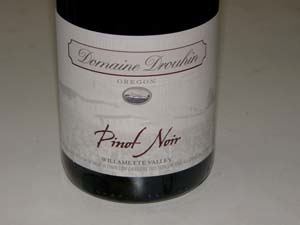 2009 Domaine Drouhin Oregon Willamette Valley Pinot Noir 14.1% alc., $40. · Light reddish-purple color the glass. Classic Dundee Hills perfume of red cherries, strawberries, sandalwood and a hint of spice holding up nicely over extended time in the glass. Moderately intense flavors that echo the nose make an impression on the mid-palate, complimented with an underpinning of faintest oak, and ending with a very long cherry-driven finish. Not as big and splashy as many 2009 Oregon Pinot Noirs, but a very charming example of power with finesse. Very approachable now but has the balance to last 10 to 15 years. Very good (+).
2008 Domaine Drouhin Oregon Laurène Dundee Hills Oregon Pinot Noir 13.9% alc., $65. A finest lots selection named after Véronique’s elder daughter and first produced in 1992. Available in magnum ($150) and Jeroboam ($325) formats. · Moderately light reddish-purple color in the glass. The fruit aromas have not completely arrived in the wine, so the scent of dark red cherries and berries is overshadowed by oak. Bright and lively flavors of black cherries, black raspberries, cola, and sassafras led by oak undertones that are prominent at this immature stage. A serious, polished wine that is moderately intense and structured, yet displaying an admirable elegance, and finishing like a three hour movie you don’t want to end. You could drink a bottle now, but it would be a crime as the wine needs several years to emerge and shed its oak wrap.
More Oregon treats
13.5% alc., $17, screw cap. A large production blend that is consistently dependable. · Moderately light reddish-purple color in the glass. Aromas of cherry pie, spice, vanilla and seasoned oak. Crisp cherry flavor in a straightforward, lighter style with well honed structural tannins and bright acidity. Soft in the mouth with admirable finesse, finishing with a mild herbal oak note. Good.
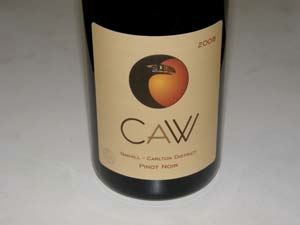 2008 CAW Yamhill-Carlton District Willamette Valley Pinot Noir 13.4% alc., 329 cases, $36. Coats and Whitney Vineyard is a sustainably farmed, 10-acre site midway between the townships of Carlton and Yamhill that was established in 2004. There are 7.5 acres planted to Pinot Noir (75% Pommard and 25% Wädenswil). Soils are quick draining Willakenzie. Second vintage of this wine. 100% de-stemmed, 5 day cold soak, aged in 25% new French oak barrels. · Moderate reddish-purple robe in the glass. Welcoming aromas of black cherries, strawberry jam, violets and sweet oak. Medium-bodied flavors of nicely spiced cherries, raspberries and plums with a floral note persisting on the finish. Very smooth and charming in the mouth with well proportioned tannins and overall impeccable balance. Very good.
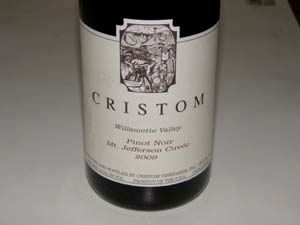 2009 Cristom Mt Jefferson Cuvèe Oregon Pinot Noir 14.2% alc., $27. Winemaker Steve Doerner is a master blender and this blend is always a dependable wine. Native yeasts, minimal handling, unfiltered. Always the first Cristom released each vintage, it is an early drinking wine of great value (often found discounted below the retail price). · Moderate reddish-purple color in the glass. Plenty of whole cluster spice on the nose highlighting the strawberry and cherry fruit aromas. Discreetly concentrated flavors of darker red berries accented by hints of anise, earth, chocolate and oak. Juicy and crisp with some firm, dry tannins. Very approachable now, but will benefit from another year in bottle to soften the tannins and boost the charm. Very good.
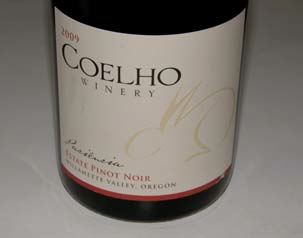 2009 Coelho Winery Paciência Estate Willamette Valley Pinot Noir 13.0% alc., pH 3.90, TA 0.51, 525 cases, $40. Clones are Pommard and Dijon 777. Native yeast, aged in 20% new French oak barrels sur lie for 10 months. · Moderate reddish-purple color in the glass. Bombastic aromas of black cherries, spice, seasoned oak, brier and rose petal. Stunning black cherry and black raspberry liquor-like flavor. Palate-staining, yet discreetly concentrated and light on its feet, finishing with large scale fruit flavors that last for a minute. Hints of allspice, oak and tar in the background. Still great the next day from a previously opened and re-corked bottle. An instant festive occasion.
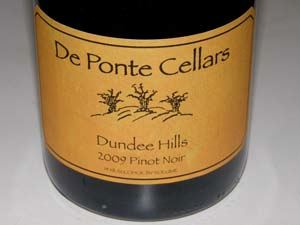 2009 De Ponte Cellars Dundee Hills Willamette Valley Pinot Noir 14.1% alc., 1,881 cases, $38. From the De Ponte estate vineyard. French oak aged for 12 months in 20% new and 80% 2 to 5 year-old barrels. · Moderately light reddish-purple color in the glass. Full-on perfume of fresh boysenberries, potpourri, incense, and Moroccan spices. Lip smacking black cherry and boysenberry essence with subtle oak, musk and spice undertones. Everything you want in a Pinot Noir: mouthwatering attack, bright acidity, ripe tannins, a lingering finish and impeccable balance. A stylish and sensual pleasure.
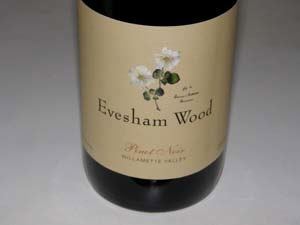 2009 Evesham Wood Willamette Valley Pinot Noir 13.0% alc., 1,650 cases, $14.79 (full retail $18). Produced from sustainably grown grapes in non-irrigated vineyards (Illahe, Eola Springs, Hidden Rocks and Mahonia). Aged 11 months in 10% new French oak barrels. Unfiltered. · Light in color with a reddish hue. Good aroma volume of strawberries, cherries, sandalwood and dried red rose petals. Tasty core of red berries, red cherries and red plums with a respectable mid palate attack. Elegantly styled and forward drinking with a cherry-filled and refreshing finish. Typical reserved but charming Evesham Wood style. Very good and a steal at this price. (The 2010 vintage of this wine has been released)
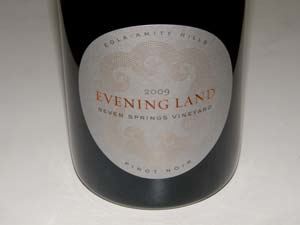 2009 Evening Land Seven Springs Vineyard Eola-Amity Hills Willamette Valley Pinot Noir 13.75% alc., pH 3.56, TA 0.54, 1,528 cases, $40. Own-rooted Pommard with some 114, 115 and 777. Planted in 1984, 1988, and 1993 to 1996. Volcanic basalt soils of the Jory series. 100% de-stemmed, indigenous fermentation, aged 12 months in 25% new French oak barrels. Bottled unfined and unfiltered. Winemaker is Isabelle Meunier and consulting winemaker is Dominique Lafon. · Moderate reddish-purple hue in the glass. Muted aromatically and slightly reduced initially, offering over time aromas of black cherries, smoky oak and humus. Medium-weighted mix of dark red and black berry and black cherry fruits backed by moderate grainy tannins, finishing with a spiced fruit, oak-marked finish. I rechecked the wine from a previously opened and re-corked the next day and two days later, and the wine become much more expressive over time, with brighter fruit aromas and flavors while still retaining a noticeable oak underpinning. Great potential here, but the wine needs more time in bottle. Very good.
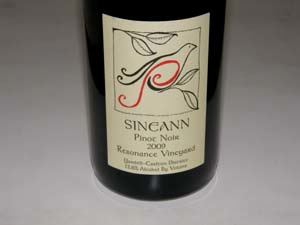 2009 Sineann Resonance Vineyard Yamhill-Carlton District Willamette Valley Pinot Noir 13.8% alc., 1,000 cases, $40, Vino-Seal. Sineann’s best Pinot Noir each year. The vineyard is meticulously farmed by Kevin and Carla chambers using biodynamic techniques. Yields are about two tons per acre. Pommard and Wädenswil clones. · Moderate reddish-purple color in the glass. The nose is floral and savory rather than fruity initially with black cherry aromas gradually emerging over time in the glass. Dark berries, black cherries and Damson plums are featured with a slight hint of tarry oak. Soft in the mouth, becoming more expressive over time in the glass. Mildly muscular tannins with a dry, berry jam finish. Much better the following day from a previously opened and re-corked bottle. Resist the urge to open it now. Love the glass closure. Very good (+).
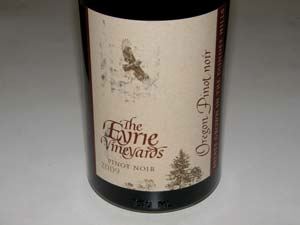 2009 The Eyrie Vineyards Dundee Hills Willamette Valley Pinot Noir 13.5% alc., $35. · Moderately light reddish-purple color in the glass. Demure aromas of fresh cherries, herbs and rose petals. Soft and delicate in the mouth with charming red cherry fruit flavor, finishing long and dry with a slight cut of citrus and a riff of herbs accenting the red fruits. A reserved and elegant offering in the classic Pinot Noir mold that is easy to embrace. Very pinotesque.
2009 White Rose Vineyard Estate Willamette Valley Pinot Noir 13.8% alc., $24. · Very appealing nose displaying aromas of fresh cherries, black raspberries, spice and subtle oak. A lighter-weighted style with charming cherry fruit, picking up intensity over time in the glass. Still a bit tight, with tannins mildly secluding the fruit flavors and the nose currently trumping the palate. Needs another 6 to 12 months in bottle. Good (+).
Good Pinot for a Ten Spot?
The Pinot Project is a negociant bottling from Michael Skurnik Wines, a New York based importer and distributor of estate bottled wines from around the world. The excellence of The Pinot Project is a reflection of the soft economy which has made quality grapes and juice available at low prices. The vineyard and or winery sources are not disclosed. The inaugural vintage was 2009. The wines are in wide retail distribution. The label won’t win any awards for style and class, but the wine inside is what is important.
 2010 The Pinot Project California Pinot Noir 13.5% alc., $9.99. · Moderately deep reddish-purple color in the glass. Complex and pleasant nose offering scents of black cherries, cut flowers, spice and Herbs de Provence. The flavors echo the nose with added notes of cranberries, Hoison sauce and a touch of citrus on the finish. Well-structured with appealing acidity. A solid wine intended for early and daily drinking. Good (+).
Hahn Winery is under the umbrella of Hahn Family Wines and is located on the Monterey Coast in the Santa Lucia Highlands. Grapes are sourced from estate and non-winery owned vineyards in the Santa Lucia Highlands and Arroyo Seco appellations of Monterey County. The winery did not have a single Pinot Noir vine in 2000, but is now a leading producer of Pinot Noir under the Hahn Winery, Hahn SLH, Lucienne and Cycles Gladiator labels. The wine below is widely distributed and available on the winery’s website at www.hahnfamilywines.com. Hahn’s vineyard holdings are shown on the map below.
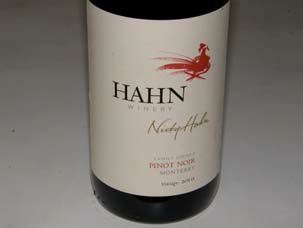 2010 Hahn Winery Monterey Pinot Noir 14.5% alc., pH 3.71, TA 0.58, $7.99 (full retail is $12). · Moderate reddish-purple color in the glass. Very enticing aromas of crushed black raspberries, black cherries, cardamom and Asian 5-spice, smoky oak, and a floral riff. Delicious sweet black cherry flavor with a hint of oak-derived flavors of vanilla and smoke in the background. Light in weight showing good finesse and a striking cherry-soaked finish. My wife is a cherry freak and loved this wine. The wine was still solid the next day from a previously opened and re-corked bottle. Amazing wine for this price. Imagine, a case for less than a C-note. Very good.
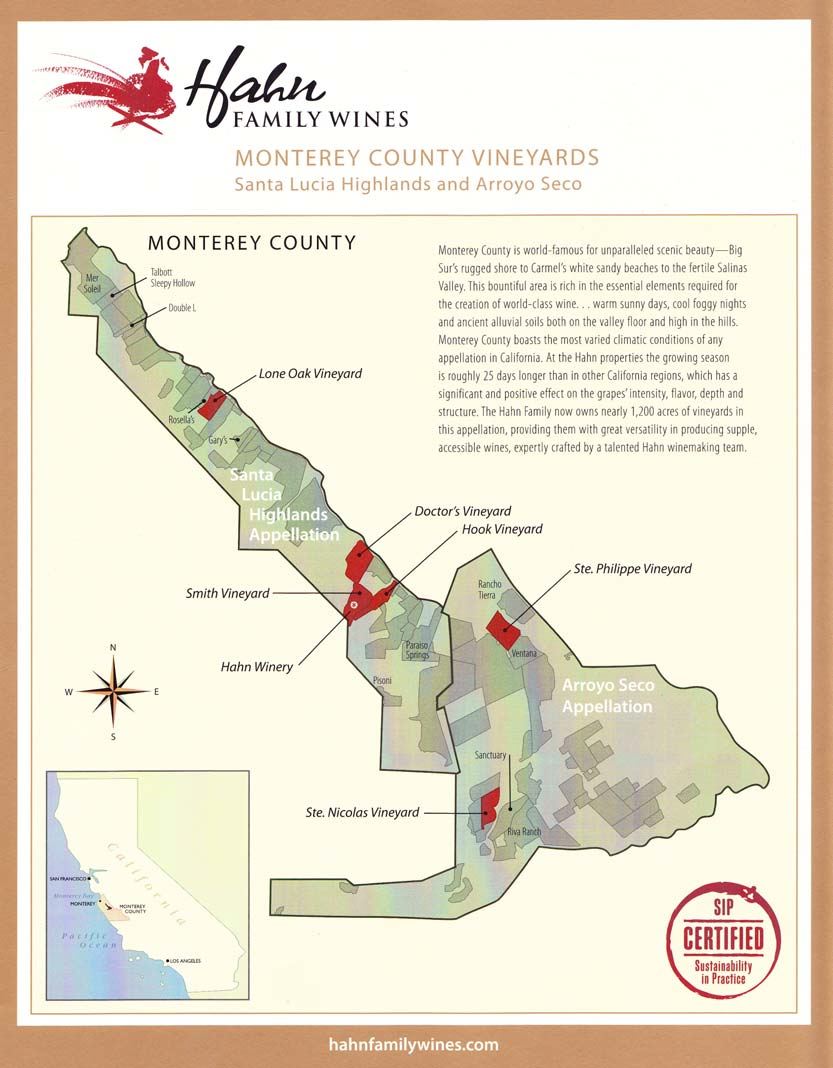
Wines Off The Beaten TrackBodega Chacra is located in the Río Negro Valley of northern Patagonia, 620 miles south of Buenos Aires, an area that for the most part produces basic reds. Río Negro shares the same latitude with most of New Zealand. In 2004, Piero Incisa della Rochhetta, whose family owns Tenuta San Guido, the producer of Sassacia, purchased the first of Bodega Chacra’s vineyards, Treinta y Dos, a small, abandoned vineyard planted in 1932. This vineyard of gnarled Pinot Noir vines was planted on its own rootstock. The vineyard’s porous soils are dominated by coarse alluvial pebbles and significant limestone content. Piero Incisa has discovered and bought two other old wine Pinot Noir vineyards which are the source of two Bodega Chacra single-vineyard wines beginning with the 2006 vintage. The first, from a vineyard planted in 1955 called Cinquenta y Cinco, and the second, from vines planted in 1967 called Sesanta y Sete. A fourth wine, reviewed here, named Barda, is produced from declassified components of the single vineyard wines as well as wine from a recently planted 10-acre vineyard on the original property. Farming is organic and Demeter certified biodynamic. In 2005, a new winery was constructed at the site of the 1932 vineyard. The inaugural releases came in 2006. The winemaker is renowned Danish-South African vintner Hans Vinding-Djers. The wines are fermented with indigenous yeasts in small cement tanks with some lots undergoing carbonic maceration. The wines are exported to the United States by Kobrand. For the full story, consult an article written by Natalie Guinovart, CWE, DWS, titled “Bodega Chacra,” in the Sommelier Journal, March 15, 2011.
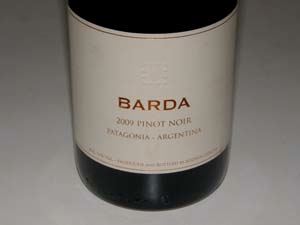 2009 Bodega Chacra Barda Patagonia Argentina Pinot Noir 14.0% alc., 4,657 cases, $31. · Moderate garnet color in the glass. Lovely aromas of black cherries, raisin and rose petals. Black cherry essence with a dusting of firm tannins and an underpinning of savory mushroom flavors. Silky in the mouth with an appealing earthiness and minerality finishing with some persistence. Very unique and unlike any California Pinot Noir I have had. Better the next day from a previously opened and re-corked bottle. Very good.
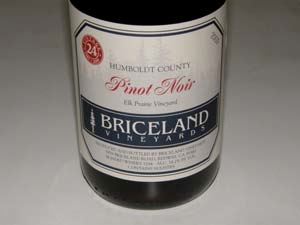 2009 Briceland Vineyards Elk Prarie Vineyard Humboldt County Pinot Noir 14.2% alc., 125 cases, $27. · Moderately light reddish-purple color in the glass. Bright aromas of black cherries, blueberries, sandalwood, forest floor and vanillin increasing in appeal over time in the glass. Complex and nuanced, with flavors of raspberries, ripe strawberries, cherries, baking spice, cinnamon, and sassafras. Strikes a chord on the mid palate, elegantly soft in texture, finishing with modest but pleasing intensity. There is plenty going on in this chameleon of a wine which changes constantly in the glass. Outstanding.
2010 Briceland Vineyards Spirit Canyon Vineyard Mendocino County Arneis Table wine, $17. Arneis is often called the “white Nebbiolo.” This Italian grape was discovered sparsely interplanted with Nebbiolo grapes in the Italian Piedmont region. Some say because the grape ripens earlier than black Nebbiolo, it was offered to marauding bees plaguing the vineyards. Recently the grape has found its way to California where it is planted along the Russian River south of Ukiah by Glenn McGourty at his Spirit Canyon Vineyard. · Pale straw color with a hint of peach shade in the glass. Aromas of green apple, baked pear and marzipan. Light to medium-weighted and creamy on the palate with flavors of green apple, pear, apricot and a slightly grassy, nutty note. An easy drinking wine that would be an ideal aperitif or the perfect accompaniment to shellfish. Surprise your friends! Very good.
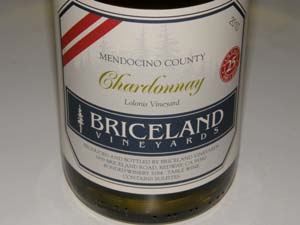 2010 Briceland Vineyards Lolonis Vineyard Mendocino County Chardonnay Table wine, $21. Crafted from certified organically grown grapes. · Pale straw color in the glass. Fresh aromas of rocky stream, lemon curd and buttered brioche. Slightly creamy on the palate with restrained but satisfying flavors of pears, white peach and citrus complimented by subtle oak. Flows off the back of the palate like a silk sheet in retreat. Beautifully crafted.
Other wines.
2008 Rippon Vineyard Hotere White Wine Lake Wanaka Central Otago Osteiner 11.0% alc., $14, screw cap. Osteiner is a variety born of Riesling and Sylvaner, planted at Rippon since the earliest days. Imported by Station Imports, Colorado Springs, Colorado. · Very pale straw color in the glass. Aromas of petrol (not a defect) and old book. Delicate flavors of tropical citrus, lemon and white peach with a noticeable petrol presence. A unique wine with tight, vibrant acidity, soft and light in the mouth, with a very dry finish. Would be excellent with white fish or shellfish. Good (+).
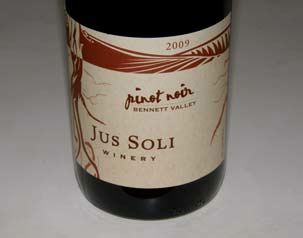 2009 Jus Soli Winery Bennett Valley Sonoma County Pinot Noir 13.6% alc., 75 cases, $30. This Santa Rosa, California producer’s name is derived from the Latin, “Law of the Soil.” Gold Medal winner at the 2011 San Francisco Chronicle Wine Competition. · Moderate reddish-purple color in the glass. Shy aromas of berry jam on toast, berry cobbler, seasoned oak and leaf. Pleasing flavors of raspberry coulis and strawberries with subtle accents of savory herbs, vanilla and red cherry Life Savers. A lighter, elegant wine with supple tannins that is easy to like. Very good.
2008 Matanzas Creek Winery Bennett Valley Sonoma County Pinot Noir 14.5% alc., $24. Matanzas Creek has been quietly producing Pinot Noir for many years. · Moderate reddish-purple color in the glass. Darker berries and cherries, modestly oaked, are offered in a medium intensity style with soft tannins and a sour cherry finish. More oak-driven the next day from a previously opened and re-corked bottle. Drink now. Decent.
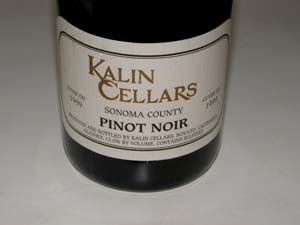 1999 Kalin Cellars Cuvee DD Sonoma County Pinot Noir 13.0% alc., $45. The current Pinot Noir release from Kalin Cellars. The fruit is sourced from the Demostene Ranch in Alexander Valley, the oldest Pinot Noir planting in that region. · Moderately light reddish-purple color in the glass with mild bricking of the rim. Aromas of oiled wood, spice, pipe smoke and soy sauce. Dark, redder fruits with secondary age related flavors of bacon fat, soy sauce, oak, mushroom and cassis. Moderate intensity with a crisp, juicy finish. Holds up nicely in the glass over time despite its age. Will thoroughly please old wine lovers and really shows off the umami flavors that old Kalin Pinot Noir is known for. Very good.
Women Pinot Noir Winemakers: You’ve Come A Long Way
The large number of legends surrounding wine goddesses supports the contention that women played an important role in the history of wine. Siduri, for example, is referred to as the Maker of Wine in the Epic of Gilgamish. Women’s modern contributions to wine production were initially delayed by gender discrimination. A recent article by Leslie Gevirtz (Thomson Reuters October 24, 2011) regarding noted winemaker Merry Edwards, reminds that Merry Edwards had a difficult time breaking into the wine business forty years ago because of the industry’s traditional preferential bias toward men winemakers. When she attended University of California Davis, there were no women professors. Edwards notes that in the early 1970s, she was trying to get her first job in the wine industry and a large California winery tried to steer her into research, a New Zealand winery refused a job interview, and another winery turned her away when they saw her walk into the winery. A new website, www.womenwinemakers.com, reported in August 2011 that 9.8 percent of the lead winemakers in California are women. The website was created by Dr. Lucia Albino Gilbert, a professor of psychology and counseling at Santa Clara University. The goal of the website is to assist women interested in a career in winemaking and to provide information to allow them to further their careers. Dr. Gilbert relied on the Wines & Vines Winery Directory and Buying Guide for an official list of wineries, but independently identified the winemakers. I believe the total percentage of California women winemakers is higher than the 9.8 percent figure for lead winemakers, at least regarding Pinot Noir producers with which I am familiar. There are many women currently working as assistant winemakers and/or enologists whose true numbers are very difficult to quantify and were not included in that figure, and there are many spouses of male winemakers or winery owners who participate in the winemaking process. In addition, there are a number of small wineries that may have been omitted. Many women have very discriminating palates and can be of tremendous assistance in assembling blends and making winemaking decisions. Women winemakers have a touch with Pinot Noir, and are able to capture the delicate texture and elegant nuances of the grape. David Autrey of Westrey Wine Company in McMinnville, Oregon, has said, “Women show a sense of balance in winemaking that you don’t see with men.” Here is a list of women winemakers at wineries that specialize in or produce Pinot Noir. The list is not complete and I would welcome you to notify me of any female vintners that I have overlooked. I suspect the percentage of women winemakers in Oregon is less than that of California.
Abigal Adams: Beth Adams
A to Z: Cheryl Francis
Along the Pinot Trail in California
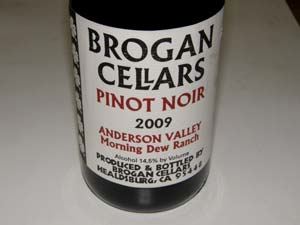 2009 Brogan Cellars Morning Dew Ranch Anderson Valley Pinot Noir 14.5% alc., $65. Sourced from Burt Williams’ vineyard. · Dark reddish purple color in the glass. Fresh aromas of dark cherries and berries with hints of herbs and brioche. A full mouthful of Pinot Noir, featuring flavors of ollaliberry pie, blackberries and mocha. Very smooth and sexy with perfectly balanced t n ‘a. Delicious the next day from a previously opened and re-corked bottle. A wowzer.
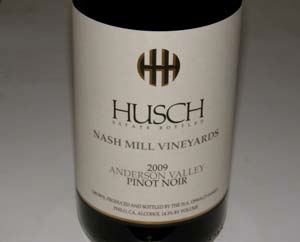 2009 Husch Nash Mill Vineyard Estate Bottled Anderson Valley Pinot Noir 14.3% alc., 18 cases, $40. This winery is celebrating 40 years. The vineyard from which the grapes are sourced is located at the cool northern end of the Anderson Valley. Planted in 2003, the vineyard consists of four acres of Pinot Noir and includes clones Pommard 5 and Dijon 667 and 777. Very low yields due to frost in this vintage. · Moderately light in color in the glass. Embracing aromas of black cherries, black raspberries and woodshed picking up intensity over time in the glass. An hi-collared wine with crisp and bright flavors of dark cherries, dark red berries, cola, baking spice and Hoison sauce, wrapped in ripe, grainy tannins, finishing with an amazing persistence rarely seen in California Pinot Noir. Beautiful interplay between fruit and tannin. Class in the glass that will thoroughly please Pinot connoisseurs. Only available at klwine.com.
2009 Londer Vineyards Corby Vineyard Anderson Valley Pinot Noir 14.4% alc., $28. · Moderately light reddish-purple color in the glass. Vibrant aromas of strawberries, cherries with a confected note, fading over time in the glass. Ripe strawberry and red cherry flavors in a lighter, silky styled wine with an earthy underpinning. Nothing out of place but doesn’t excite. Decent.
2009 Mary Elke Anderson Valley Pinot Noir 14.3% alc., $18. · Moderately deep reddish-purple color in the glass. Lovely mix of berry and candied black cherry aromas with added subtle notes of dried rose petals and potpourri. Very tasty with an impressive mid palate attack of spicy black cherry and Hoison sauce flavor, offering some persistence of cherry fruit on the dry finish. Medium-weighted, sweet, ripe and forward, with supple tannins and supporting acidity. Impressive wine at this price point. Very good.
 2009 Saracina Klindt Vineyard Anderson Valley Pinot Noir 14.2% alc., $30. A boutique winery founded by John Fetzer and spouse Patty Rock in 2001. · Moderately dark reddish-purple hue in the glass. Shy and demure aromas of black raspberry jam with an exotic tea note. A beautiful wine with plenty of earthy dark fruit presence in the mouth. Notes of spice, brewed tea, and plum sauce add interest. Crisp and clean with a minerality evident on the long aristocratic finish. Impeccably crafted to last in the cellar. Still fine the next day from a previously opened and re-corked bottle.
North Coast
2009 On Point Christina’s Cuvèe North Coast Pinot Noir 13.9% alc., 306 cases, $34. Released June 16, 2011. Sourced from Londer, Gap’s Crown and Floodgate vineyards. Clones 115, 667, 777, 828 and Swan. Aged 15 months in 27% new French oak barrels. Bottle aged 6 months. · Pleasant perfume of mixed dark berries, plum and oak. Soft and smooth, but rather nondescript, with flavors of blackberries and dark plums and some black cherry showing up on the finish. Gossamer tannins make for easy drinking but the wine lacks focus. Decent (+).
2009 Pfendler Vineyards Sonoma Coast Pinot Noir 14.5% alc., 400 cases, $45. This wine incorporates fruit from each one of Kimberly Pfendler’s four vineyards located in the Petaluma Gap (Penngrove, Pullis, Helgren, and Pfendler). Clones are Swan, Calera, Pommard and Dijon 828.Crafted by noted winemaker Greg Bjornstad. 100% de-stemmed, 7-day whole berry cold soak, 8 months sur lees aging and 11 months total aging in 50% new French oak barrels. · Moderately deep reddish-purple color in the glass. Aromas of darker fruits with hints of pepper and oak vanillin. Moderately rich and intense blackberry, cassis and sweet black plum flavors persisting through the lengthy, fruit-driven finish. A bit clunky and out of sorts now, needing another 6 to 12 months in bottle to fully come together. Good (+).
Russian River Valley
2009 Holdredge Old School Russian River Valley Pinot Noir 13.2% alc., $38. · Moderately dark reddish-purple color in the glass. The aromas are promising, offering scents of black cherries, brewed tea, baking spice and subtle oak char. On the palate the wine is oaky, with flavors of burnt wood, under ripe red fruits, green notes and piercing acidity on the finish. A flawed wine. Unsatisfactory.
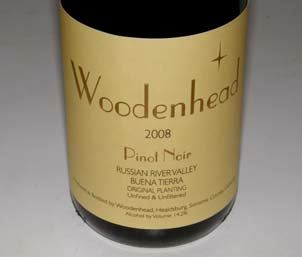 2008 Woodenhead Buena Tierra Original Planting Russian River Valley Pinot Noir 14.2% alc., 198 cases, $60. Last vintage for this vineyard designate as the vineyard is dying out due to phylloxera. Unfined and unfiltered. · Moderately deep reddish-purple color in the glass. Brooding aromas of cherries, spice, and oak vanillin. Delicious fruit bombast featuring perfectly ripe flavors of black cherries and black raspberries, with notes of sassafras, cola and exotic spices. Very broad in the mouth and distinctive, leaving a lovely cherry kiss on the lingering finish. Harmonious in every way. I guarantee you will love this wine. An All- American for sure.
Santa Cruz Mountains
2007 David Bruce Santa Cruz Mountains Pinot Noir 14.7% alc., $27. · Moderate reddish-purple color in the glass. Aromas of black cherries, leaf and oak lead to flavors of strawberries, black raspberries and cherries. Earthy with sweet tasting fruit that is veering toward an overripe profile. Well oaked with firm tannins and sharp acidity on the finish. Decent. (This winery, which at one time produced stellar Pinot Noir under the hand of David Bruce, is now a commercial high-output factory of mostly generic appellation-based Pinot Noir. Bruce’s advancing age prevents him from being significantly involved in the winery)
2008 McHenry Estate Swan Clone Estate Bottled Santa Cruz Mountains Pinot Noir 14.3% alc., 74 cases, $35. From a special block in a 2.3-acre vineyard at 1,800 foot elevation the top of Bonny Doon Road, five miles inland from the Pacific Ocean. The vines derive from cuttings propagated from Joe Swan’s vineyard. Aged 21 months in Francois Freres French oak barrels. · Light reddish-purple color in the glass. Aromas of redder fruits, spice, green stem and geranium. Classically styled with elegant flavors of red cherries and supportive notes of oak, sandalwood and green garden. Bright acidity with mild fine-grain tannins, finishing with a dusty, spiced red fruit quality and a hint of grapefruit. A delicate wine that will not appeal to blockbuster Pinot Noir lovers, but has its charm. Good.
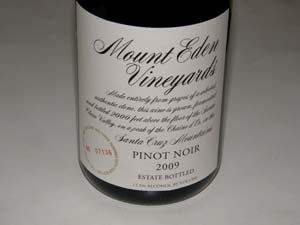 2009 Mount Eden Vineyards Santa Cruz Mountains Pinot Noir 13.5% alc., 780 cases, $49. Grown and bottled at the estate 2,000 feet above the floor of the Santa Clara Valley. · Moderate reddish-purple color in the glass. Muted but attractive nose offering aromas of berry cobbler and pumpkin spice. Really wakes up the mouth with flavors of dark red raspberries and strawberries, black cherries and plum sauce with complimentary oak. Very classy juice with well-mannered tannins, and bright acidity on the remarkably long, mineral-driven finish. A clear statement of terroir. Very young, becoming more interesting and fruity over time in the glass, and simply great two days later from a previously opened and re-corked bottle. Best to decant if you must drink now.
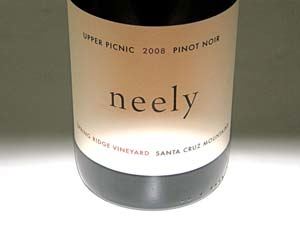 2008 Neely Upper Picnic Block Spring Ridge Vineyard Santa Cruz Mountains Pinot Noir 14.1% alc., $37. The Spring Ridge Vineyard, located in Portola Valley, is owned and farmed by Varner and offers six blocks: Hidden, Home, Amphitheater, Bee, Upper Picnic and Picnic. Varner is known for Chardonnay but produces superb Pinot Noir under its own label and Pinot Noir under the Neely label. Dr. Kirk Neely owns the Spring Ridge Vineyard and the wines are crafted by Varner twins Jim and Bob Varner. · Moderately light purple color. Fresh and clean aromas of mixed berries, black cherries and spice box. Delicious on the attack with an emphasis on nicely spiced black cherries. Vibrant and refreshing with mild tannins and some persistence on the finish. The impeccable balance predicts age ability.
2008 Neely Hidden Block Spring Ridge Vineyard Santa Cruz Mountains Pinot Noir 14.6% alc., $37. · Moderately light reddish-purple color in the glass. Ripe and fruity nose with aromas of black cherries and darker berries with a hint of oak. Earth-kissed black cherry and dark red berry flavors with an appealing earthiness and supportive oak highlights. Medium-weighted, crisp and juicy, with silky tannins. A wine for those who prefer the earthier, riper side of Pinot Noir. Very good.
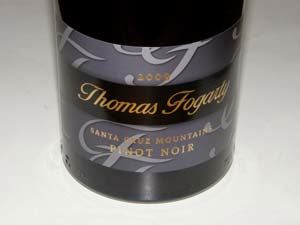 2009 Thomas Fogarty Santa Cruz Mountains Pinot Noir 14.1% alc., pH 3.80, TA 0.55, 1,286 cases, $24. 66% estate vineyard, 34% four other Santa Cruz Mountains vineyards. 25-50% whole cluster, indigenous yeast fermentations. Aged 10 months in 33% new 3-year air-dried French oak barrels. · Medium reddish-purple color in the glass. Modest fruity aromas of cherries, berries, red plums and yeasty brioche, picking up intensity over time in the glass. Tasty core of red and black berries and plum with a hint of leaf and herbs. Silky in the mouth with moderate dry, dusty tannins. A well-structured offering that aims to please. Good (+).
2008 Varner Three Blocks Spring Ridge Vineyard Santa Cruz Mountains Pinot Noir 14.3% alc., $37. · Moderately deep red color in the glass. Aromas of forest floor, berry jam, and oak vanillin. Darker fruits are featured including blackberries and black currants. Earthy and brooding with fairly firm tannins and the slightest oak in the background. Silky textured with a very respectable fruit presence on the finish that should benefit from further bottle aging. Try not to pop the cork for a year or two. Very good.
Santa Barbara County
2009 Alta Maria Santa Maria Valley Pinot Noir 13.9% alc., $24. Sourced from Bien Nacido and Solomon Hills vineyards among others. · Moderately light reddish-purple color in the glass. Alluring aromas of black cherries, berries, wood spice and toast. Flavorful red and black cherries, raspberries, and red plum with supportive oak notes. Medium-weighted and crisp with some length on the finish. Well-structured with fine-grain tannins and comes across refined and silky on the palate. A terrific value. Very good.
2009 Pali Wine Co. Fiddlestix Vineyard Sta. Rita Hills Pinot Noir 14.7% alc., 112 cases, $48, screw cap. Clones 667, 777, 115 and Pommard 4 from this vineyard that was planted in 1998. Aged 15 months in 50% new French oak barrels. · Moderate reddish-purple hue in the glass. Aromas of deep, dark fruits with hints of oak, spice and vanillin, veering to roasted fruit aromas over time in the glass. Intense and attention-grabbing flavors of blackberries, black raspberries, black currants and the faintest oak, persisting on the fruit-driven finish. Very plush and soft in the mouth. Plenty to like in this wine, but the ripeness of the fruit distracts. Good (+).
2009 Pali Wine Co. Cargassachi Vineyard Sta. Rita Hills Pinot Noir 14.8% alc., 48 cases, $48, screw cap. Clone 115. Aged 15 months in 50% new French oak barrels. · Medium reddish-purple color in the glass. Aromas of humus, underbrush, oak, and cut flowers with a hint of alcohol peaking out. Darker fruits are featured with a rustic, earthy bent. Moderately aggressive tannins with some very pretty black raspberry and black plum fruit. A savory wine that carries a floral note to the finish. Good (+).
2009 Queen of Hearts Santa Barbara County Pinot Noir 14.5% alc., $12.29. Nice package. · Light reddish-purple color in the glass. Charming aromas of strawberries, cranberries, balsam, red hard candy and spice fading some over time in the glass. Light, even dilute, with cherries featured. Hints of strawberries, vanillin and sandalwood add interest. Alcohol peaks out on the finish. An easy drinker that has enough charm to hold your attention. Decent (+).
Making Sense of ReductionReduction is a term used by winemakers and wine critics in the context of wine production and evaluation that wine drinkers rarely understand. It is like the Big Bang theory: a mysterious dark energy that hardly any normal person apprehends. Fortunately, we have talents who can explain reduction in understandable terms. The following offers unedited discussions of reduction and its significance in wine evauation from Allen Meadows, aka Burghound, and a very geeky, scientific discourse on reduction’s role in fermentation from Kerith Overstreet, M.D., the cerebral winemaker for Bruliam Wines.
Without getting into a chemical analysis (see Overstreet’s discussion below), of which I am ill-equipped to guide you anyway, this practice often results in a highly reductive environment in barrel, which simply put is the absence of oxygen. Winemakers have long understood that too much oxygen, particular in whites, is not a good thing because it oxidizes them and in extreme cases, can turn both reds and whites prematurely brown. However, the reverse can be taken to an extreme as well and when this occurs, a condition known as reduction occurs. A reduced wine smells dirty and in particular of sulfur compounds. A heavily reduced wine will taste of it as well and when extreme reduction occurs, mercaptans appear. Mercaptans smell of burnt rubber, garlic, stale sweat among other descriptors and suffice it to say, that is very unpleasant and if not corrected, can ruin a wine. Reduction is, generally speaking, easily cured simply by introducing oxygen. As a practical matter, the way that this is most often done is to rack the wine from one barrel to another, which introduces oxygen and eliminates most of the lees (though sometimes they are kept and added back). However, if reduction appears in a finished, bottled wine, it is a clear flaw and while aeration (decanting) will usually clear it up, some wines are permanently reduced and about all that can be done is to put a penny in the wine. Sounds bizarre, but it works! (Note that my wife suggests a clean penny). The reason that reduction is significant is because it renders a wine particularly difficult to judge. Slight reduction is not something to worry about because the basic characteristics of the wine are still evident. Heavy reduction that extends to the flavors makes a wine almost impossible to accurately judge and if the condition is left untreated it can permanently mark a wine. This risk explains why traditional practice in Burgundy is to rack a wine after the malolactic fermentation is finished so as to introduce some oxygen and thus dissipate the reductive aromas. However, with ever more precise analytical tools, a winemaker can push the edge of the envelope in this regard and still not reach a condition where more radical or invasive solutions are required to fix a problem. While this practice probably does result in richer and more complex wines, it makes the review process extremely difficult while the wines are in this state. I share this with you in the interest of full disclosure as I make every effort to judge a wine as accurately as possible but when there are limitations on my ability to do so, it’s incumbent upon me to say just that......It stands to reason that the closer any wine is to its finished state the more accurate the guidance will be.
“Redox” is an abbreviation of reduction and oxidation. These are terms that describe the way organic compounds swap and exchange electrons. When you gain an electron, it’s called reduction. Your overall charge is more negative; you’re reduced from no net charge to say -1. if someone steals your electron, you’re oxidized. Since oxygen is notorious for swiping electrons from unsuspecting compounds, electron loss is called oxidation. There is a nifty pneumonic for this: “OIL/RIG.” Oxidation is loss (of electrons) and reduction is gain (of electrons). This concept is paramount since electrons are energy. In fact, electron energy potential is stored in a compound called NADH. NADH can give away an electron to become NAD+. When this happens, NADH is itself oxidized, the electron recipient is reduced since it takes that electron. NADH’s potential energy, in the form of electron donations, is known as “reducing power.” NADH energy drives cellular functions and metabolism. It’s energy currency, but it goes both ways (like wife swapping). Say you’ve got a lot to do so you burn through all of your NADH savings. Well, you’re stuck with a stockpile of NAD+. From an energy perspective, it’s pretty useless. It’s like finding an empty Gu wrapper at mile 20 of a marathon. Its a black fly in your Chardonnay. Even so, you need some way to convert your NAD+ back to the good stuff, so you can proceed with your day. Enter fermentation. Along the path of fermentation, grape sugars travel the trajectory from sticky, sweet grape juice to vino. The very first step of fermentation is a chemical conversion that initiates the magic, when grape sugars are transformed to pyruvate. Listen, you don’t want to down a kegger of pyruvate, but it’s a start. But in order for glucose and fructose to become pyruvate, they need to give up an electron. What you say? You mean glucose and fructose are oxidized to pyruvate? Yes, it’s true. And can you guess who sops up all of those freebie electrons? NAD+ of course. Fermentation actually helps recycle the NAD+ and renews the energy coffers. In fact, early fermentation, during the yeast exponential growth phase (characterized by an orgy of asexual budding), yeast require lots and lots of reducing power and harness the power of NADH to grow and reproduce. Luckily, our insatiable appetite for wine can make that happen. I’ve got bins of glucose and fructose at the ready. You are aware that the final step of fermentation is the conversion of acetaldehyde to ethanol. This is the most important step since it makes wine, wine. Ethanol is the final electron acceptor. It’s a Hanukkah miracle come early. Acetaldehyde is reduced to ethanol. You know that the electron comes from NADH, the same stuff that was recycled when glucose and fructose were oxidized back at step #1. It’s a perfectly balanced cycle. The first step of fermentation generates the reducing power (NADH) that ultimately reduces acetaldehyde to ethanol. Ethanol captures that final electron, regenerating the NAD+ necessary to keep the machine churning. Yeast stockpile a pretty limited supply of NAD+, and without its regeneration, fermentation of grape sugars would grind to a halt. To keep fermentation moving, the redox balance must remain in check. The yeast adjust to the evolving flux in sugar, temperature, and alcohol by tinkering with and maintaining the redox balance.”
Pinot Briefs
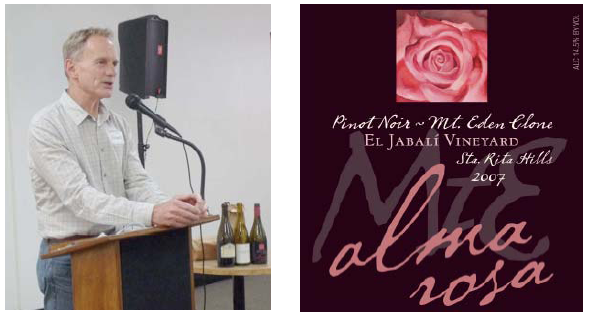 New Winemaker for Bien Nacido and Solomon Hills Brands The Miller Family, who own Bien Nacido, Solomon Hills and French Camp Vineyards, have named Trey Fletcher as winemaker for their two new labels. Before joining Miller family brands, Fletcher worked in the Napa Valley and Argentina, became the Assistant Winemaker at Domaine Alfred, and most recently, was the Assistant Winemaker at Littorai. This was a smart hiring, as Trey is a very talented winemaker who brings youth and enthusiasm as well as invaluable experience at Littorai to the Miller family brands program. Agronomist Pat Williams was also added to Miller Family’s team. Charge Your Car While Tasting Wine Inman Family Winery is the first Sonoma County winery to have a privately owned, solar-powered electric vehicle (EV) charging station for the public. The system was installed at the winery’s tasting room at Olivet Grange Vineyard at 3900 Piner Road in Santa Rosa. Owners Kathleen and Simon Inman have embraced solar and sustainable practices at the winery. The solar panels, inverters and connections placed on the roof of the new winery, which was designed with the same roofline of the 19th century barn that it replaced, were placed in a 160-degree azimuth look angle to the sun which is close to the optimal 180-degree angle. Another bit of news from Inman Family Wines is the release of their first sparkling wine, the 2009 Inman Family OGV Brut Rosè Nature Endless Crush, what Kathleen calls, “The most delicious wine I have ever made.” Commemorating her 25th wedding anniversary, the wine was vinified at Rack & Riddle in Hopland to make use of their specialized equipment for sparkling wines. 138 cases of the wine ($52 with discounts for multiple bottle purchases) were disgorged October 11, 2011. Visit www.inmanfamilywines.com. Latest Statistics from Wine Institute & US Gov As of 2010, there were 3,364 bonded wineries in California and 7,626 bonded wineries in the United States. California wine grape acreage totaled 476,377 (reported bearing and non bearing) and 535,000 estimated total when unreported acres are included. California Pinot Noir acreage was 37,290 acres in 2010. Oregon Pinot Noir acreage, in comparison, was 12,265 acres, or 60.4 percent of the state’s 20,300 acres of wine grapes. The full Grape Acreage Report for 2010 is available at www.nasss.usda.gov. Vinosum Vinosum is a valuable resource for those seeking to geo-tag single vineyard wines. Data is personally researched and hand entered for California wines and the single vineyards from which they originate. Wine Advocate scores for single vineyard wines are in the geocatalog as well as soil types, varieties planted and average bottle price. A tremendous amount of work went into this site, yet it is currently offered free of charge.

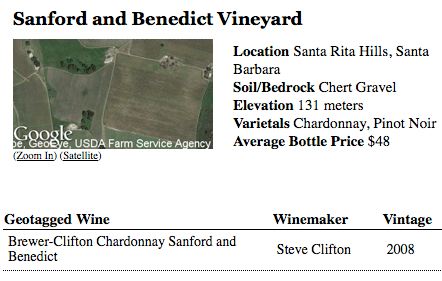 Noted Bay Area Wine Critic Robert Finigan I never had the opportunity to meet Robert Finigan who shared his birth year with me (1943). He toiled in relative obscurity compared to Robert Parker, Jr., but was nevertheless a significant early contributor to wine reviewing. He began publishing Robert Finigan’s Private Guide to Wines in 1972, and according to his obituary in the Los Angeles Times (October 20, 2011), was an early champion of offering “bracingly honest evaluations of fine European and emerging California wines.” Matt Kramer said, “He was arguably the first hard-core critic who clearly took the gloves off and he was the first great consumer advocate for wine lovers.” He was known to be a very good taster of Pinot Noir and Burgundy. He later began reviewing restaurants and started publishing Robert Finigan’s Private Guide to Restaurants, and became an influential restaurant critic in the San Francisco Bay Area. He used a simple rating system for wines: Outstanding, Above Average, Average, or Below Average, arriving at his ratings by purchasing wines in retail stores and evaluating them blind. Finigan stopped publication of his newsletter in 1990. Treasure Island Wines Jim Mirowski started Treasure Island Wines in 2007, creating a 10,000-squarefoot urban winery (Winery SF) on San Francisco Bay’s diminutive Treasure Island which is less than one square mile in size. The Winery SF is an events venue offering holiday parties, weddings, private tastings and wine-themed events (www.winery-sf). The winery is in a former aircraft hangar where Steven Spielberg filmed “Indiana Jones and the Last Crusade.” The hanger and event space is also home to a separate enterprise run by winemaker Bryan Kane who crafts wine under several labels including Vie Winery, Sol Rouge Vineyard & Winery, and Winery SF. For more information and to view a listing of events, visit www.winery-sf. In a separate building on the island, winemaker Patrick Bowen produces red wines with no added sulfites under the Fat Grape label. Another winery on the island is Bottega Wine Estates which hosts multiple producers and offers a cooperative tasting room, offering a tasting of a diverse range of wines for $5. A fifth separate winery facility will open soon, Kendric Vineyards, where owner Stewart Johnson plans to open a tasting room and crush there next Fall. All the wineries are separate entities that occupy different buildings scattered around the island. The ultimate goal is to turn Treasure Island into a wine tasting destination of San Francisco Bay wine enthusiasts. Preservation Ranch Future Threatened The California Public Employees’ Retirement System (CalPERS) has withdrawn its ties with the vineyard management firm, Premier Pacific Vineyards (PPV). PPV was planning Preservation Ranch, a 1,769-acre conversion of forest land to vineyards on 20,000 acres in Annapolis on the Sonoma coast. CalPERS has a majority investment in Preservation Ranch. The project has caused a national stir because of widespread opposition from environmentalists including the Sierra Club’s Redwood Chapter. An environmental impact report will be out at the end of 2011. Wine Industry Insight reported that Premier Pacific Vineyards 130+ employees (tractor drivers to executives) were left in limbo, all of them fearing their jobs would be gone by January 1, 2012.
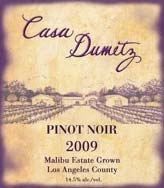 Casa Dumetz Actor, writer and producer Emilio Estevez started Casa Dumetz in Malibu in 2004, planting a 1-acre Pinot Noir vineyard. The first crop in 2008 made about 50 cases of wine. Estevez’s fiancee, Sonja Magdevksi, is the winemaker. The Malibu Estate Grown Los Angeles County Pinot Noir is 80% Pinot Noir and 20% Grenache. Understandably, the wine sells out quickly. In addition, the winery produces Viognier, Syrah, Grenache and a Sparkling Syrah Rosè from Tierra Alta Vineyard in the Santa Ynez Valley (all priced under $30). The website is www.casadumetz.com. Estevez wrote and directed a new film, “The Way,” starring his father, Martin Sheen. The film is about a wine and food fueled journey along the Camino de Santiago (Way of St. James) in Spain. Highly recommended viewing. Contemporary Fine Art Wine-Themed Murals on Stone Tile Beyond Wow offers fine art murals on stone marble including the whimsical wine art of Frenchman Gèrard Puvis. Perfect for wine cellars, dining rooms and patios. Visit www.beyondwowtileart.com.
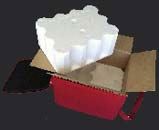 Take Your Wine On Flight The Wine Check is a lightweight piece of baggage that holds a case of wine, insulated and protected by a foam insert. The Wine Check has wheels making it easy to transport to and from the airport. FAA approved, the package allows you to stay under the 50 pound airline weight limit for luggage. The Wine Check is collapsible and reusable. Cost is $59 with the foam insert. Visit www.thewinecheck.com. Australian Pinot Noir Vintner Wins Nobel Prize Three astrophysicists, including Brian Schmidt of Australian National University, were awarded a Nobel Prize for their revolutionary work that demonstrated that the universe is accelerating rather than slowing down as Albert Einstein had theorized. Schmidt owns a property in Canberra where he planted 2.5 acres of Pinot Noir in 2000 and produces wines that are attracting attention. The region is not known for Pinot Noir, but Schmidt’s goal is to craft a Pinot Noir that makes the region proud. Last year, James Halliday gave Schmidt’s label, Maipenraim, four-star status, and local wine critics have been generous in their praise for his 2008 Pinot Noir. His wines are sealed with Vino-Lok glass stoppers. New Willamette Valley Mobile Wine Tour Willamette Valley Mobile Wine Tour makes it easy to explore wine country, giving you information on over 180 wineries. You can search for nearby wineries and get turn-by-turn directions instantly. Scan the QR code at www.willamettewinemap.com to take you directly to the Mobile Wine Tour. Wine Historian Lecture by John Winthrop Haeger On Tuesday, November 15, 2011, noted author and wine historian, John Winthrop Haeger, will present a conversation, “Solving Mysteries: Evidence in Wine History,” at 7:30 P.M. in 222 T.J. Day Hall at Linfield College, where he has previously taught. The program is free and open to the public. For information, call 503-883-2498. Heart of Healdsburg Celebration Hotel Healdsburg and Charlie Palmer’s Dry Creek Kitchen are hosting the Heart of Healdsburg Celebration November 11-13 in honor of the hotel’s and restaurant’s 10-year anniversary. Chefs Charlie Palmer and Dustin Valette will kick off the weekend Friday night with a Gala Dinner at Dry Creek Kitchen. The menu will be paired with ten wines from noted Sonoma County wineries including J, Ramey, Martinelli, Rochioli, Williams Selyem, Rafanelli and Rodney Strong. Special wine and culinary experiences will follow that weekend including Farmers’ Market Tour and Cooking Demonstration, Quivera Winery and Vineyards Winemaker for a Day, Williams Selyem Winery Barrel Tasting, and Mauritson Winery Excursion. For information and Weekend Packages visit www.hotelhealdsburg/heart-of-headsburg/ J Vineyards & Winery new Sparkling Clear Bottle J has always led the way with stylish marketing and the new stunning package for their Brut Rosè continues the trend. A sexy new makeover has resulted in a sleek clear bottle displaying the wine’s seductive color. The grapes for the Brut Rosè are hand-harvested into small quarter ton bins and placed as whole clusters, without de-stemming, into a special Coquard press for a gentle pressing cycle in the traditional saignèe method. Retail is $28. Visit www.jwine.com.
 San Luis Obispo Vintners Association Harvest Celebration Weekend The 21st Rockin’ Harvest Celebration will be held November 4-6, 2011. The Grand Tasting and Auction will take place on Saturday, November 5, at the Avila Beach Golf Resort with over 60 wineries and restaurants from the San Luis Obispo region featured. Many other events are planned all weekend such as the Sinor-LaVallee Winemaker Dinner with Mike Sinor at Et Voila Restaurant in San Luis Obispo. A four course meal will be paired with a selection of Mike’s library wines ($85 pp, cheri@sinorlavellee.com). For more information and tickets, visit www.slowine.com. Alder Yarrow Teams With Jancis Robinson JancisRobinson.com has a very large following in the United States and as a result, has decided to recruit noted wine blogger, Alder Yarrow, to add an American presence on her website. Yarrow founded Vinography.com in 2004 and has garnered more awards than any other wine blogger. He will write a provocative monthly column, titled Alder on America, focusing on what is currently preoccupying American wine enthusiasts. His first article, published October 19, was a consideration of the effects of Robert Parker’s ceding coverage of California wine to his heir-apparent Antonio Galloni. Alder’s column will be available to Purple pages subscribers only at www.JancisRobinson.com. Sunset Magazine Western Wine Awards Sunset magazine editors, celebrity guests, and winemakers gathered at the Sunset Western Wine Awards Gala in Pismo Beach as part of the Sunset Savor the Central Coast food and wine event. More than 500 nominated wines were tasted before narrowing the field to 32 finalists. Steal of the Year Award ($15 and under): Gruet Nonvintage Blanc de Noirs, New Mexico, $15. Connoisseur Award went to 2009 St. Innocent Zenith Vineyard Eola-Amity Hills Pinot Noir. Winemaker of the Year was presented to Isabelle Meunier of Evening Land Vineyards in Oregon. Low Alcohol Wines a Hit in UK Low (up to 5.5% abv) and no-alcohol wines are growing in popularity in the UK and approaching 1 million cases in sales. The sector has appeal because consumers are looking for lower-alcohol alternatives to their regular wine and the low-alcohol wines offer lower prices than full strength wines. Alcohol Associated with Better Survival after Heart Attack Women who drank anywhere from a few alcoholic drinks a month to more than three a week in the year leading up to a heart attack ended up living longer than women who never drank alcohol, according to a recent study published in the American Journal of Cardiology. The study indicated a 35 percent lower chance of dying during the follow up period for women who drank compared to those who didn’t. There were no differences observed between the different drink types suggesting it is the alcohol itself that is beneficial. Other studies have found that people who continued to drink moderately after having a heart attack had better health than those who abstained. GM Grape Vines An Australian scientist in Adelaide has developed genetically modified grape vines that are resistant to mildew. The research scientist, Ian Dry, says the vines have not been tested in the field because Australia’s wine industry, and Europe where a large portion of Australian wine is exported, are not supportive of GM technology. Dry said that he was able to identify two genes from North American grape vines that confer resistance to downy and powdery mildew and then transfer those into a number of wine grape cultivars, including Shiraz, creating transgenic vines. NW Wine Company Opens in Dundee The huge 44,000-square-foot, 500,000-gallon-capacity facility is owned by winemaker Laurent Montalieu and his wife, Danielle Andrus Montalieu in partnership with investor John Niemeyer and his son-in-law Jeff Meader. Plans are in place to process 2,000 tons of grapes during the 2011 harvest, making the facility number two in Oregon wine production behind King Estate. Approximately 30 brands including the new Hyland Estates label will be produced at the new winery along with several lots vinified separately for custom crush clients. Hyland Estates wines will be featured at a tasting room adjacent the winery housed in a former private home. Brooks Wines Celebrates 10-Year Anniversary To commemorate the ten-year anniversary of Brooks Wines and honor the life of founder, Jimi Brooks, the 2008 Brooks Red-Letter Day Pinot Noir will be released. Although its founder is deceased, Brooks Wines continues to produce award winning Pinot Noir and Riesling through a strong commitment to organic and biodynamic farming, a gentle approach to winemaking and a celebratory approach to both winemaking and life. The 2008 Brooks Red-Letter Pinot noir is priced at $75 and only 200 cases were produced at Brooks‘ new winery in the heart of the Eola-Amity Hills of the Willamette Valley. The fruit is from WillaKenzie, Momtazi and Brooks Estate Vineyards. To obtain the wine or for more information, visit www.brookswine.com. Pinot Days Chicago Pinot Days returns to the Navy Pier in Chicago for its fifth year on November 12, 2011, showcasing over 70 winemakers and over 300 Pinot Noirs from California, Oregon and New Zealand. For more information and to purchase tickets, visit www.pinotdays.com. Use my code, PINOTFILECH11 for a 10% discount. Drink Leucadia Red on Veteran's Day Leucadia Red is a boutique wine company founded in the coastal community of Leucadia, combining Sonoma County wines, the surreal artwork of local artist Jami Goddess, and a note of positive, spiritual inspiration on its wine labels. According to Leucadia Red founder Dave Archinal, Leucadia Red is donating a portion of profits from the sale of it's 2008 Red Blend Bordeaux-style California wine named "The General" to organizations like The Wounded Warrior Project. The winery also offers a Sonoma County Pinot Noir and a Russian River Valley Pinot Noir. Visit www.leucadiared.com for more information.
¡Salud! 20th Anniversary Auction Item: Russian River Valley Immersion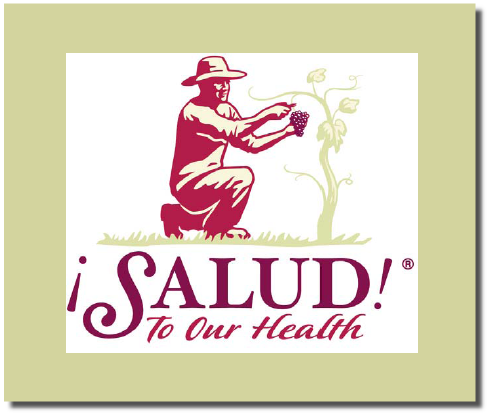 The Prince is offering a hosted four day, three night exploration of Sonoma County’s Russian River Valley. Home to more than 150 growers and over 100 wineries, this 200 square mile valley in the heart of Sonoma County has sustained farmers for more than 150 years, and remains an agricultural oasis that is today one of the most prestigious wine regions of California.
This live auction package includes:
If you are unable to attend this year’s auction on November 12, 2011, you can submit a sealed bid at http:// www.saludauction.org/auction/the-oregon-pinot-noir-auction/auction-items/. Last year’s package sold for $4,500. |